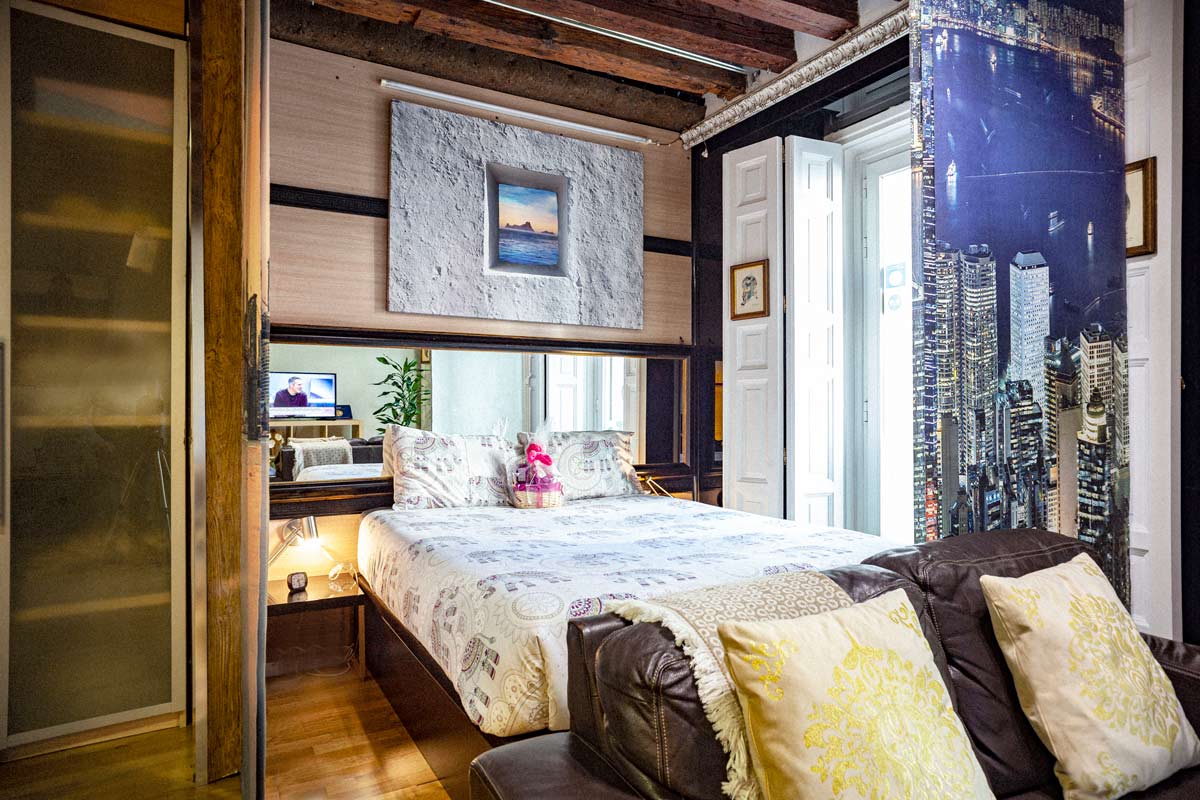If you’re planning to discover Madrid and immerse yourself in its rich cultural heritage, renting a vacation apartment might be the key to an unforgettable experience. Discover now the advantages of renting an apartment in the heart of Madrid. Benefits … Read More
English
Flamenco show in Madrid. What is the best tablao?
Flamenco is an art that mixes dance, singing, guitar and percussion. Flamenco originated in the south of Spain and can be seen in many Spanish cities. If you come to visit Madrid we advise you to reserve your place to attend a Flamenco show. In order to avoid booking your seats in a tourist flamenco tablao without soul we have made a selection of the best addresses.
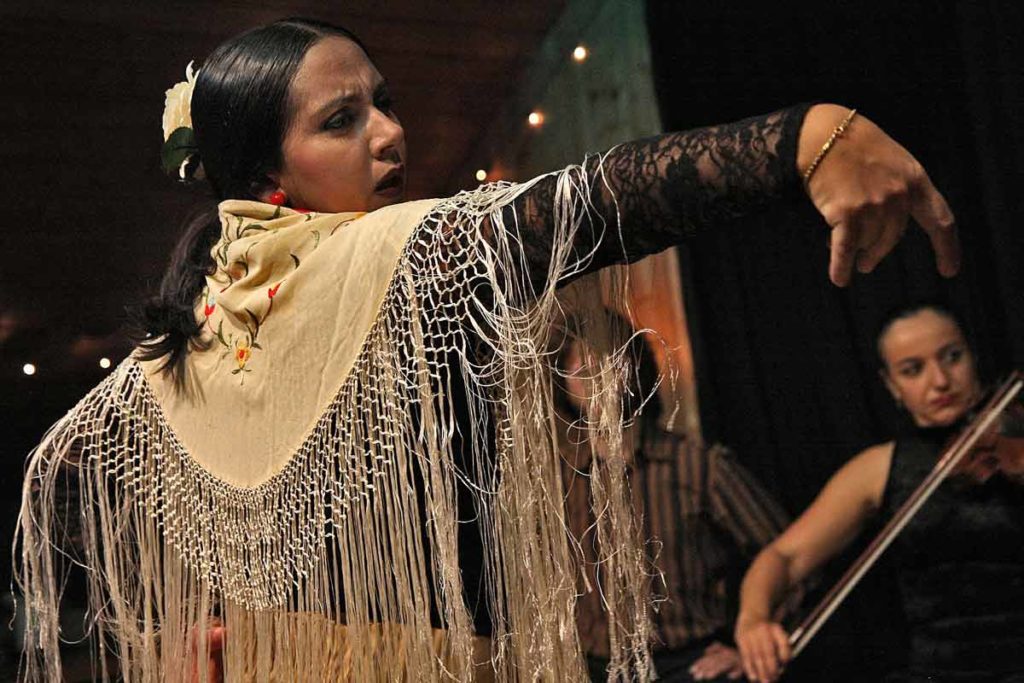
The best flamenco tablao in Madrid
Which flamenco show to choose in Madrid? Where to see flamenco in Madrid? Which tablao flamenco to choose? Many of you have asked us how to choose a flamenco tablao in Madrid and which is the best tablao in the capital.
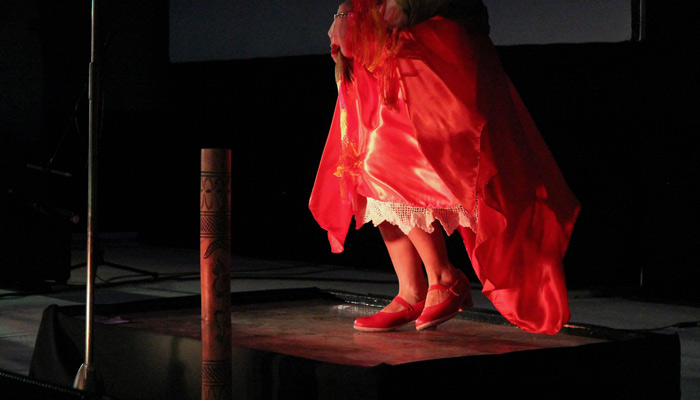
The Reina Sofia Museum, the complete guide
Find out in this article why the Reina Sofia Museum in Madrid attracts so many visitors.

The Museo Nacional Centro Reina Sofia is part of the famous Golden Triangle of Madrid’s art. It is one of the largest museums in Madrid after the Prado Museum and the Thyssen & Bornemisza Museum.
It is known all over the world for its contemporary art and for the famous paintings on display such as Picasso’s Guernica and his masterpieces.
Located in downtown Madrid in front of the Atocha train station in an old hospital, the Reina Sofia National Museum will surprise you with its unique cultural offer.
In order to answer any questions you may have about visiting the museum we have prepared a comprehensive article to prepare you for your experience and have a great time during your stay in Madrid.
Table of Contents
- What to see at the Reina Sofia Museum
- Where the Reina Sofia Museum is located
- How much does the entrance to the Reina Sofia Museum cost?
- The museum’s schedule
- Visit the museum with a French-speaking historian guide
- Why visit it with Madrid Discovery
- Organize a visit with your EC
- Visit the museum without a guide
- Visit the Reina Sofia Museum for free.
1. What to see at the Reina Sofía Museum
The museum is composed of 3 floors, a garden, a small terrace and more than 20,000 works of art are on display.
The period covered by the Reina Sofia Museum is complementary to that of the Prado Museum, they are two museums that deserve to be visited one after the other to get a chronological view of Spanish art and movements.
You will find a bookstore as well as a locker and toilets. For lovers of beautiful views we advise you to go up to the second floor to have access to a magnificent terrace.
Count 2 hours for a visit of the museum with a French-speaking guide, you will have the opportunity to study nearly 18 works. If you make the visit alone you will be able to discover up to 25-30 works (quick passage without explanations).
2. Where the Reina Sofía Museum is located
The museum is located in front of the Atocha train station and not far from the Retiro Park. The imposing building (former hospital) is quickly recognizable.
Museum address: Calle de Santa Isabel, 52, 28012 Madrid
If you come from the Thyssen Bornemisza Museum or the Prado Museum then you will only have to follow the paseo del arte to get to the National Museum in the Reina Sofia Center.
The crystal palacio of Velasquez palace are an extension of the Reina Sofia museum in Madrid, we advise you to visit them, they are located in the Retiro park just behind the Prado museum. To get there, go up the paseo del arte.
Extension of the museum: crystal palacio and Velasquez. Here you will find unique and high quality temporary exhibitions exhibiting the works of renowned artists.

Museum Terrace
3. How much is the entrance fee to the Reina Sofia Museum?
Admission to the museum is 10€. If you are over 65 years old then you will get a discount. By comparison, the Prado museum costs 15€ per person and the Thyssen Bornemisza museum costs 12€ per person.
Subject to proof of age, persons meeting the following conditions will be admitted free of charge:
- To be under 18 years old.
- Student from 18 to 25 years old.
- Journalists, people with reduced mobility, people without work.
4. Timetable of the Reina Sofia Museum
The museum opens every day at 10:00 am, it is also one of the busiest hours, you may have to wait 30-40 mins before you can enter the museum.
The solution is to come earlier to have a good place in the queue or to come later when the 10:00 am visitors have finished visiting the museum.
We advise our clients to book their visit for 3:00 pm, it is a low hour and the number of visitors is very low, which will allow you to enjoy the museum’s collection.
Monday to Saturday from 10am to 8pm
Sundays and holidays from 10am to 7pm
The Reina Sofia Museum is closed on the following days:
January 1st
May 1st
December 25th
The centro de arte reine sofia is also closed on January 6th.
5. Visit the museum with a French-speaking historian guide
The visit to the Reina Sofia Museum is one of the most surprising visits in the city, many of our clients had not thought about visiting the museum and finally chose to visit it with a guide following recommendations they got from friends.
A true cultural heritage, the National Museum Reina Sofia Center partly retraces the Spanish Civil War (with Picasso’s Guernica as the main canvas) and the history of modern Spain with the feminist movement.
One part is dedicated to Cubism and its history, you will have the opportunity to contemplate paintings by the famous painter Juan Gris and his masterpieces.
The visit of the museum without a historian guide is quite complex, cubism and contemporary art is not as descriptive as the paintings that can be found in the Prado Museum or the Thyssen Museum.
The museum visits that we offer at Madrid Discovery are developed to offer you more added value than the classic visits.
In order to offer you an exclusive and complete service, we take care of the organization of your visit as well as the purchase of the fast tickets. Your guide will pick you up directly at your hotel and take you to the Reina Sofia Museum. If you plan to visit the Museo Nacional Centro Reina Sofia with young children or teenagers, the private tour will be an excellent way to capture their attention and avoid boredom.
Don’t waste any more time and discover our tour of the Reina Sofia Museum with our English speaking guides.
6. Why visit it with Madrid Discovery
Visiting the Reina Sofia de Madrid with Madrid Discovery will allow you to live a unique and authentic experience.
Most of the guided tours that you will find in Madrid are not private and you will have to buy the tickets by yourself.
To save you from having to manage the organization of your visit we will take care of it.
Being transparent with our clients is a priority, once the reservation is made on our website you will not have to pay anything, we do not ask you to pay any cash or buy the tickets yourself.
Included in the price is a series of exclusive services such as the purchase of fast tickets, the departure of your visit from your hotel, the cab ride from your hotel to the museum and a dedicated customer service that can be reached at any time.
Can’t make the tour? Had to cancel your stay in Madrid? Don’t worry, contact customer service to get a full refund of your purchase*.
* Refund conditions are indicated in the general conditions of sale.
7. Organize a visit to the Reina Sofía with your company
The museum adapts very well to group visits and especially to company visits. We regularly organize visits to companies that come to Madrid for a seminar or during vacations organized by the EC.
Our services for companies have been developed to offer a stress-free turnkey experience. Once the visit is booked we take care of all aspects of the visit to ensure that you have a unique experience.
For more information on group tours or team-building organization please do not hesitate to contact us directly by email.
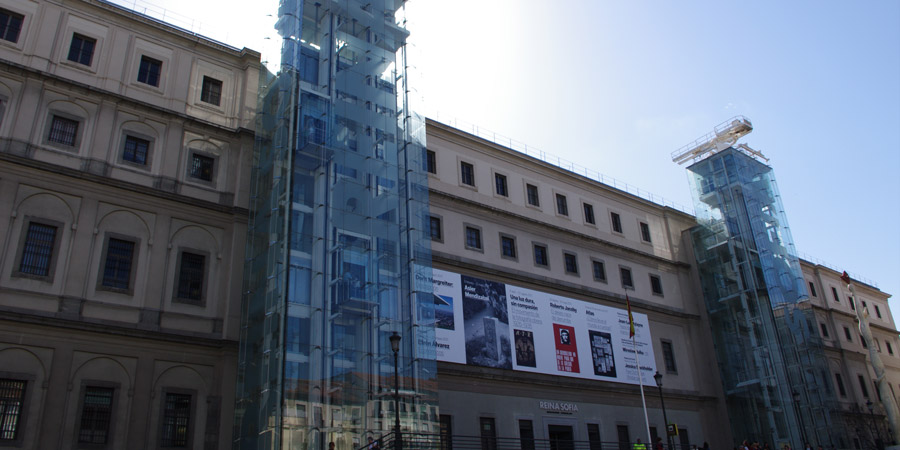
Main entrance of the museum
8. Visiting the museum without a guide
It is not an easy museum to understand and many of the works require an explanation to decipher their meaning.
It is important to understand the context of each of the works in order to appreciate the visit. Its imposing size may lose the visitor and not allow him to enjoy the experience to the fullest.
There may be some waiting when buying tickets to visit the Reina Sofia Museum. During the high season it is possible to wait more than 30 minutes to return. This is a constraint that you will not have when visiting the museum with a private guide.
9. Visit the Reina sofia museum for free
t is possible to visit the Reina Sofía Museum free of charge, for this you will have to wait for the end of the day slot between 18:00-20:00 during the week and 17:00-19:00 on weekends and holidays. You will have access to the entire collection of the museum.
Is it interesting to visit the museum for free?
Visiting the Reina Sofía Museum during this time can be interesting if you have a small budget and want to visit Madrid economically.
However, to be able to visit it you will have to start waiting from 5:00 pm or even 4:30 pm on busy days.
To be sure to return during the free schedule some people start waiting very early. In general the number of people who enter for free is quite high and you will not be able to visit the museum in the best conditions.
To sum up, visiting the Reina Sofía Museum for free may be interesting but requires some sacrifice of time and comfort. It is important to note that temporary exhibitions are not open to the public for free.
This article was first published on May 25, 2020. It is regularly updated with news and new activities.
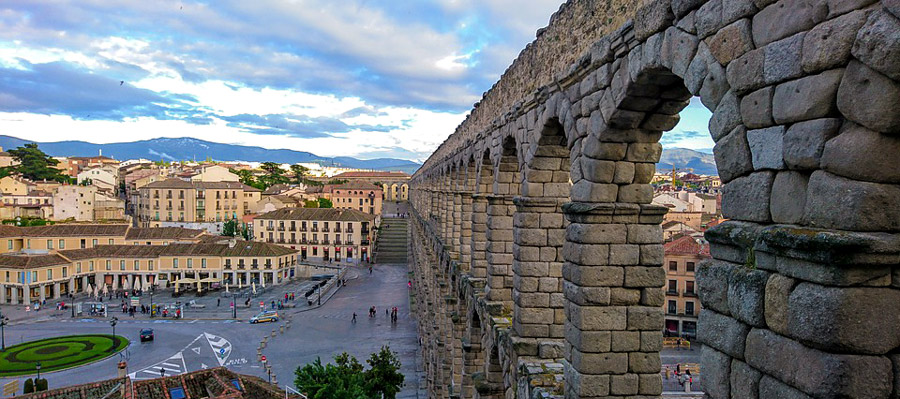
The history of Segovia
Segovia is a medieval city located in the centre of Spain, about 100 km from Madrid.
Capital of Spain in the Middle Ages, its central geographical location allowed the various kings to maintain their power in Spain.
Famous in part because of its aqueduct which revolutionized the lives of its inhabitants, Segovia is one of the most beautiful medieval cities in Spain.
Discover throughout our article everything you wanted to know about this magnificent medieval city.
If you wish to visit the medieval city then you will find in this post everything you need to organize your stay.
The Segovia Aqueduct
Mainly famous thanks to its imposing aqueduct, it was built during the Roman Empire around the first century AD.
It brought water from the river hechebeda for almost 2000 years directly into the city. The water was stored in large tanks and redistributed to the city’s inhabitants, allowing them to have quick access to water.
The Segovia aqueduct is 813 metres long and almost 29 metres high at its highest point.
It consists of 127 arches and 20,000 granite blocks. The peculiarity of this building is that there is no trace of mortar between the stones that form it.
The masons have applied an engineering system based on physics – the stones rest one on top of the other. To achieve this result they used wooden structures where they made the stones rest, once the whole was stable the wooden structures could be removed.
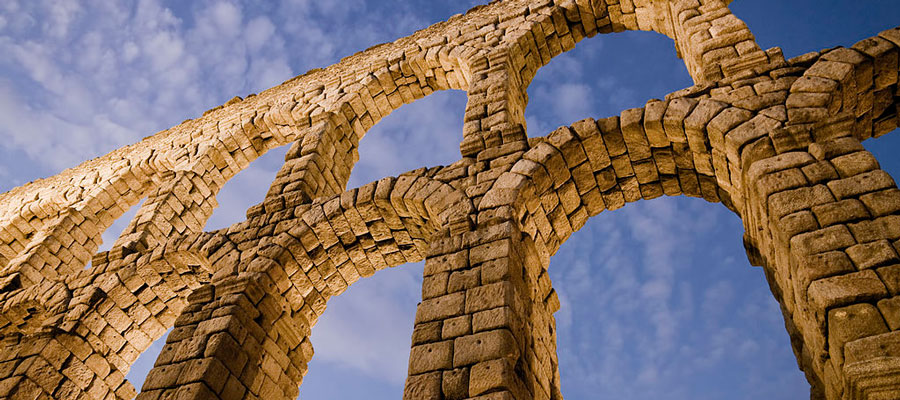
The Segovia Aqueduct
Who built the Alcazar de Segovia
Research shows that the Alcázar de Segovia was built with the same stones as the aqueduct, which means that it was built by the Romans.
In order to strengthen the protection of the Alcázar and to protect the fortress as well as possible, its builders built it at the foot of a ditch more than 20 meters deep.
Naturally deep, it is from this ditch that the stones were extracted to create the Alcázar and the aqueduct, making it even deeper and more dangerous.
It is possible to see the traces left in the ditch when the stones were cut.
Alfonso 8 the Noble was one of the first monarchs to live in the Alcázar, followed by a large number of monarchs.
The Alcázar was a place where many decisions on the legacy of the Spanish crown were made.
Its visit is very interesting and we advise you to take an audioguide if you do not have a private English speaking guide.

Alcazar of Segovia
Visit Segovia from Madrid
The advantage of visiting Madrid is that there are a multitude of cities like Segovia and Toledo that can be visited in one day. In another article we will tell you more about what to do in Toledo, a medieval city classified as a UNESCO National Heritage Site.
Segovia is famous all over the world for its citadel, aqueduct and gastronomy. In this article we will tell you about the different things to do during your stay in Segovia and you will see that despite its small size not everything can be visited in one day.
How to get to Segovia
Segovia is part of the Autonomous Community of Castilla y León, named “historical and cultural community” for its great cultural wealth.
It is made up of nine provinces: Avila, Burgos, León, Palencia, Salamanca, Segovia, Soria, Valladolid and Zamora.
It is the largest autonomous community in Spain and the sixth most populated, with 2,409,165 inhabitants.
The city of Segovia is located in the northwest and is an hour’s drive from Madrid. There are three options to get there:
The first option is to go by car.
You can easily find a car rental company in the city centre of Madrid. It takes a good hour’s drive to get there. There is an underground car park a few meters from the aqueduct.
It is also possible to book a private driver who will drive you from Madrid to the medieval city. This option is interesting if you wish to visit the city with a private guide.
Besides not having to worry about the route your guide will show you the city in an intimate and unique way.
The second, faster and cheaper solution is to take the train from Madrid Chamartin station to Segovia station.
This option is convenient, but very restrictive, you have to respect the train timetable so you don’t miss the time and once in Segovia you have to get on a bus that goes back and forth between the centre and the station.
It is quite possible to visit Segovia with a guide while leaving Madrid by train.
The last option is to take a bus from Madrid to Segovia.
The departure will be from Moncloa and you will arrive in 1h30. There are on average 1 to 2 buses per hour (EMT bus network website at the end of the article). It is the cheapest solution, but the longest.
The Madrid-Segovia connection is very easy. If you don’t want to organize this excursion yourself, don’t hesitate to write to us, the Madrid Discovery team will propose you the ideal itinerary to live a unique and authentic experience.
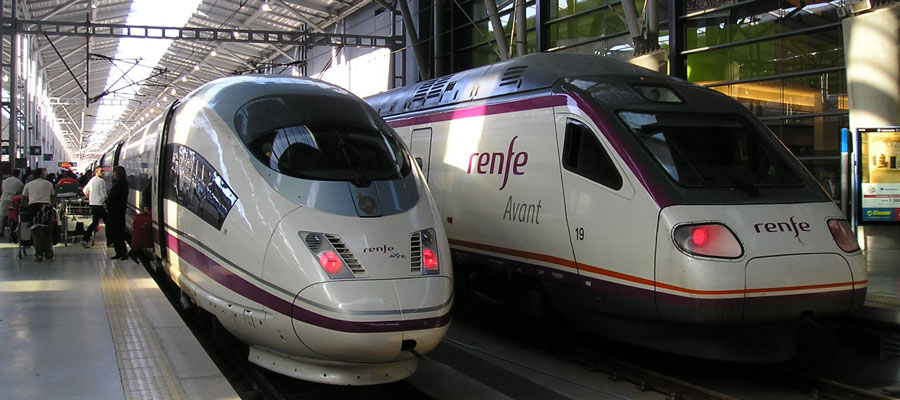
Visit Segovia Spain from Madrid
When to visit Segovia
We often get this question, it is indeed important to ask when to visit Segovia or Madrid, because some periods are not very favourable for tourism.
The ideal time to visit Segovia is from mid-March to mid-November, the most frightened will prefer the months of May to October. The temperature in summer is hot (very hot in August) and cold in winter (very cold in January and February).
If the cold doesn’t bother you then Christmas is the ideal time, the atmosphere is very warm and spending Christmas in Spain is an unforgettable experience!
It is not very common to have rain, but if you are travelling at the beginning or end of the season then we recommend that you take warm clothes to protect you from the cold and rain.
What to do in Segovia
What to do in Segovia? The advantage of visiting Madrid is that the region offers a wide variety of activities including visits to medieval cities.
The city of Segovia offers three main interests, castles, gastronomy and possible hiking around the city.
First we will list the different visits to do and then we will talk about the gastronomy and what to eat in Segovia.
The city of Segovia is one of the oldest cities in Spain where many civilizations such as the Celts, Romans and Moors have lived and left traces.
Visiting this city is therefore a step back in time several hundred years. The part of Segovia that can be visited is the old town, very easy to get to and not much frequented by tourists you will have the opportunity to visit unique monuments rich in history.
The following monuments can be visited independently, but if you prefer to visit them with a guide please do not hesitate to contact us and check our offer on our web page, we will offer you a unique experience in a confidential setting in the company of an English speaking guide.
The Alcázar of Segovia
The visit to the Alcázar is one of the most interesting tours of the city. Here you will be able to visit the different rooms where the history of Spain was written, which will offer you a complementary visit to the Royal Palace of Madrid.
Allow a good hour to visit the entire Alcázar.
The Segovia Alcázar is made up of 3 parts: the museum, the castle and the Juan 2 tower. It is possible to buy a ticket to visit all of them or to buy a ticket for each part.
We advise you to take a tour of the Juan 2 tower to have a great view of the city, but don’t forget that 152 steps of a spiral staircase await you!
Summer schedule : (from April 1st to October 31st) from 10:00 am to 8:00 pm
Winter schedule : (from November 1st to March 31st) from 10:00 am to 6:00 pm
The Alcázar is not open all year round and we advise you to visit their website for the latest updates.
Prices are available on the website of the l’alcazar, children under 5 years old have free entrance. You can rent an audio guide during your visit to the Alcázar de Segovia for 3€, it is available in more than 10 languages.
The Segovia Aqueduct
The Segovia aqueduct is part of the landscape of the medieval city, you can’t miss it. To have one of the most beautiful views of the building we recommend you take the stairs that are located on the right side of the aqueduct, once at the top you will be on the rampart and will have a great view.
Segovia Cathedral
The cathedral of Segovia, imposing by its size and architecture and a must during your visit to the city.
It is composed of 3 naves forming a Latin cross plan, the cathedral has side chapels, a transept with a semicircular apse with a choir and a tower.
It is possible to enter the cathedral through three doors: the Puerta de San Geroteo, the Puerta de San Frutos and the Puerta de Santa María.
Opening hours of the cathedral :
March to November: Monday to Sunday: 9:30 am to 6:30 pm (last passage half an hour before)
April to October: Monday to Sunday: 09h00 to 21h30 (last passage half an hour before)
The cathedral is closed 30 minutes before closing time. We advise you to visit the cathedral between April and November.

The cathedral of the medieval city
Guided tour of the tower of the cathedral of segovia
It is possible to take part in a guided tour of the tower present in the cathedral, here are the schedules :
March to November:
Monday to Sunday: 10:30 (guided tour in Spanish); 12:00 (guided tour in Spanish); 13:30 (guided tour in Spanish), (15:00 guided tour in English) and 16:30 (guided tour in Spanish).
April to October:
Monday to Sunday: 10:30 (guided tour in Spanish); 12:00 (guided tour in Spanish); 13:30 (guided tour in Spanish), (15:00 guided tour in English); 16:30 (guided tour in Spanish); 18:00 (guided tour in Spanish) and 19:30 (guided tour in Spanish)
May to October:
Friday, Saturday and Sunday: 21:30 (special night guided tour including a visit to the interior of the illuminated cathedral – in Spanish)
Muralla of Segovia
Declared a World Heritage Site by UNESCO, it is one of the most beautiful and ancient walls in Spain.
The total length of the wall is 3 km 406m and can be up to 2.5 m thick. Its height has been estimated to average around 9.50m.
The wall was composed of 5 gates acting as toll gates, currently it is possible to see 3 of them: The gate of San Andrés, the gate of Santiago and the gate of Saint-Cyprien.
Take a walk in the Jewish quarter of the old town
We advise you to visit the Jewish quarter after the wall, the walled walkway of the wall will give you a breathtaking view of the Jewish quarter of the city and the general architecture of the city.
Once the visit of the wall is over, go to the Jewish quarter of the city to discover the atypical architecture of the district.
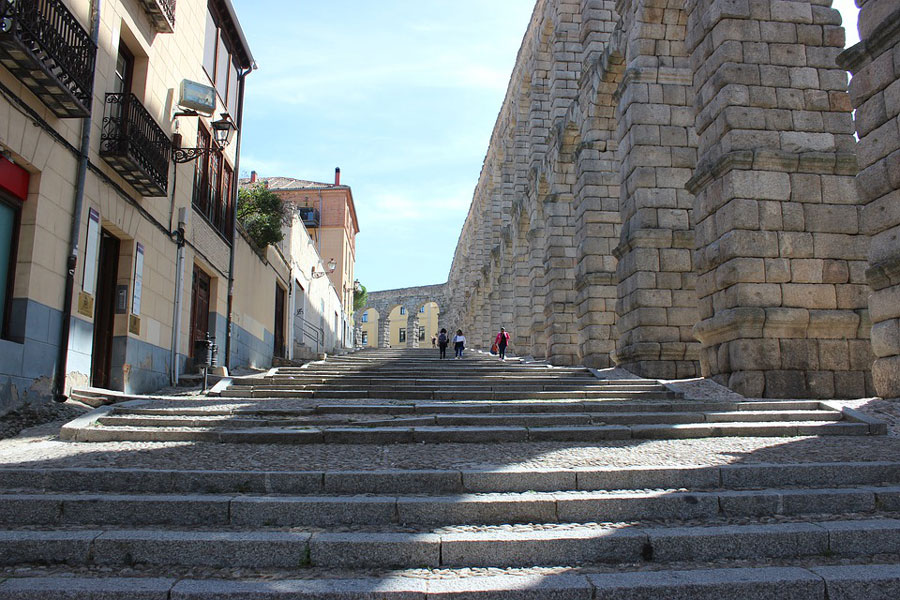
Segovia Spain
Eating in Segovia
Segovia is best known for its magnificent Roman aqueduct and its magnificent alcazar, but for food lovers from all over the world it is one of the best places to taste the suckling pig, a speciality of the region.
Visiting the medieval city is above all to taste a suckling pig and enjoy a moment of tasting during your stay in Spain.
Discover what to eat and above all where to eat the best dishes of the city.
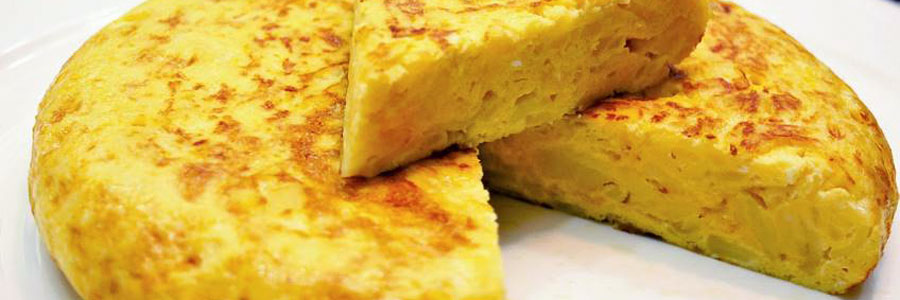
Tortilla de patatas
What to eat?
Very nourishing suckling pig is a specialty of the region, tender and tasty this dish will give you enough energy to go around the city walls again.
Crunchy on the outside and tender on the inside the suckling pig must melt in the mouth to be perfect.
This dish is very well known in the region, so much so that the people of Madrid go to Segovia on Sundays to taste it.
It is also important to note that this dish must follow some rules; the suckling pig must be no more than 3 weeks old and be fed only milk and weigh no more than 5kg.
This makes the meat very tender and tasty.
There is even a contest for the best suckling pig!
We advise you to order a suckling pig for 4 to 5 people, the chef will prepare it for you and divide it into several portions. If you travel in summer, don’t order too many dishes, because the suckling pig is very nutritious and will be enough to satisfy you.
The suckling pig is not the only traditional dish you can enjoy during your visit.
The “Judiones de la granja” are large white beans prepared in a soup, creamy and tasty this dish will be ideal when visiting the city in winter. It is often eaten with chorizo and tocino* in the manner of a Madrid cocido.
*tocino: bacon
You will find many other equally delicious dishes on the restaurant menu, to start with we recommend sharing a Russian salad, castellan soup or some croquetas. The offer of wine (mainly red wine) is also very wide in this region and would not displease you.
Finally for dessert it is imperative to taste the local pastry el ponche segoviano. Composed of a light sponge cake covered with custard and a thin layer of marzipan it will be ideal to end your meal.
*marzipan: slightly sweet almond paste.

Suckling pig
Where to eat?
After different visits to Segovia we could low the selection of the best restaurants and pastries or eat a good suckling pig and buy a segoviano poncho. In general the restaurants in Segovia are all of very good quality, so it is safe to go to the restaurant of your choice.
Here is our selection of restaurants and pastries:
Mesón De Cándido; an authentic restaurant where you can enjoy a large terrace. Very easy to find it is located very close to the aqueduct. The suckling pig is delicious and their pastries are exquisite!
La cocina de Segovia; gastronomic restaurant it will suit people looking for a more exclusive setting, the cuisine is delicious and the service of quality. Their wine list is very wide and will suit all tastes.
Jose Maria; authentic and rustic restaurant typical of Segovia. Quality suckling pig, economical wine list and family atmosphere. Far away from the tourist area, it will suit people looking for a more authentic setting.
If you wish to buy pastries and especially el ponche de segovia we recommend you to go to Lemon and Mint (on the plaza mayor) they are famous for having the best pastries of the city.

Restaurant – suckling pig
When to eat?
You probably know it and you must have realized during your first days in Spain that Spanish timetables are different from other countries, lunch and dinner are much later than in our country.
Spaniards are used to eat a sandwich or a pincho de tortilla around 11H30 / 12H00, it’s the almuerzo. This allows them to have lunch around 14H30 / 15H00.
Restaurants do not open their kitchen before 14H00, in big cities like Madrid or Barcelona it will be possible to find a table for 13H00 but this is not common.
It is the same for dinner, restaurants do not serve before 20H45 / 21H00 and it is not uncommon to reserve a table for 23H00.
Segovia’s restaurants have adapted to their international clientele and offer more flexible dining hours.
However, we suggest that you contact the restaurant via their social networks or web page to find out the opening hours.
Visit the surroundings of the medieval city
If you can easily move around by car then we recommend you to make visits outside the medieval city, you will be amazed to discover the cultural richness of this region. Discover our selection of 4 things to do around Segovia. If you like more intimate sights and places away from the crowds of tourists then these are the places for you.
Monastère de Santa María del Parral
You will have the opportunity to discover the Roman Catholic monastery of the monks of the Order of Saint Jerome, outside the centre of Segovia. Visits are not open every day and we advise you to contact the monastery directly to make a visit.
Monastery opening hours: Wednesday to Sunday from 11am to 5pm, closed on Mondays and Tuesdays.
Royal Palace of the Granja de San Ildefonso
Visit this magnificent royal palace of the Granja de San Ildefonso during your tour of the city.
Opening hours of the Royal Palace of the Granja de San Ildefonso :
From 01 April to 30 September: Tuesday to Sunday from 10:00 to 20:00, closed on Mondays.
From 01 October to 31 March: Tuesday to Sunday 10:00 am to 6:00 pm, closed on Mondays.
The palace of San Ildefonso is not open every day, here is the link to the official website of the palace.
Do you have any questions about how to organize your stay, what to visit in Madrid or which hotel to take? Don’t hesitate to write to us, our specialist guides in Madrid will help you prepare your stay.
Do you want to visit Madrid with a family with a guide? Are you passionate about art and dreaming of visiting the Prado Museum?
See you soon in Madrid.
The Royal Palace in Madrid with Madrid Discovery
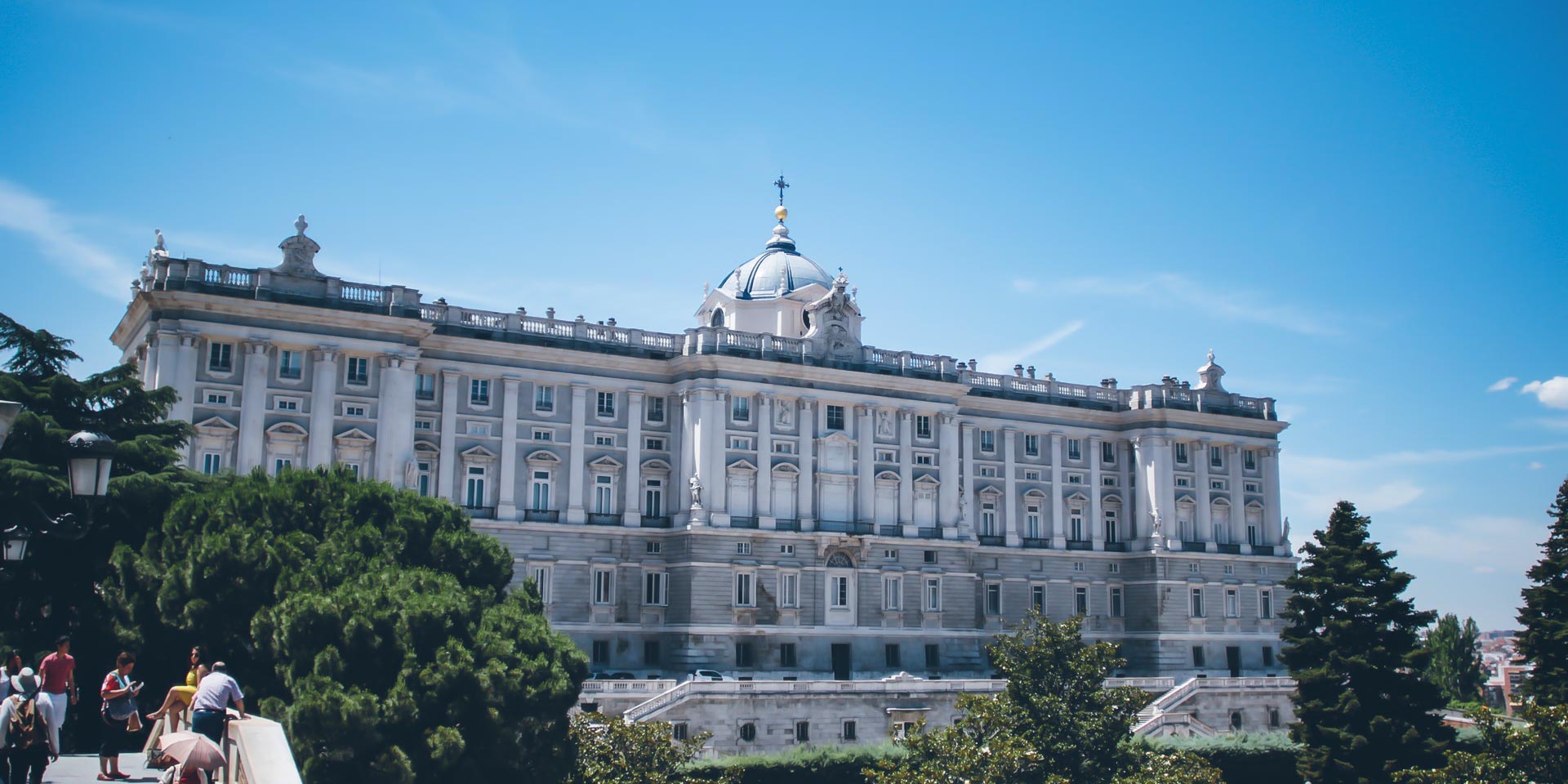
Royal palace of madrid
Private royal palce tour
The Royal Palace of Madrid is one of the monuments to see during your holidays in the Spanish capital, rich in history, it will surprise you with its rooms, each one as magnificent as the next and the richness of its decorations.
Go on a unique visit where you will discover an impressive collection of clocks, paintings by famous painters, tapestries, royal jewellery, the royal crown and even a very rare collection of Stradivarius violins unique in the world.
What to see and do at the Royal Palace in Madrid?
Before starting our guide to the Royal Palace of Madrid here is a list of the rooms to visit in the palace. We have not detailed everything so as not to spoil your visit and leave you with a bit of surprise for a successful visit.
You will have the possibility to visit :
- The Armory Square
- The main staircase
- Chamber of Charles III
- The porcelain cabinet
- The Gala Dining Room
- The Royal Chapel
- The Stradivarius Hall
- The Throne Room
History of the Royal Palace of Madrid
The history of the Royal Palace of Madrid begins during the reign of Emir Mohamed I (9th century). He chose to build a fortress in the city of Madrid to protect the ancient Spanish capital Toledo from the advance of the Christians.
It was not until the 14th century that the kings of Castile built the first Alcázar, bearing the name of Antiguo Alcázar. It was Charles I of Spain and his son Philip II who were to carry out this transformation, which was to turn the ruins into the residence of the kings.
In 1734 a fire destroyed the Alcázar and it was Philip V who directed the construction of a new palace on the ruins of the two previous ones.
He appointed Filippo Juvara to build it, but the latter died shortly after the construction began and it was his disciple Juan Bautista Sachetti who completed the construction in 1738, seven years after the beginning of the works.
The first king to reside in the royal palace was Charles III, who was also the first to decorate it.
The greatest changes in decoration were made by his successor Charles IV, who decorated the Hall of Mirrors.
Studies have shown that the Royal Palace in Madrid is inspired by the organization of the Louvre in Paris made by Bernini. In both structures we find a square courtyard, a gallery and a main facade of the palace overlooking the military square.
The Royal Palace of Madrid has nearly 3000 rooms, a staircase designed by Sabatini with more than 70 steps, a throne room with a magnificent fresco by Tiepolo, a guard room formerly a ballroom, a royal chapel and a room dedicated to Stradivarius stringed instruments.
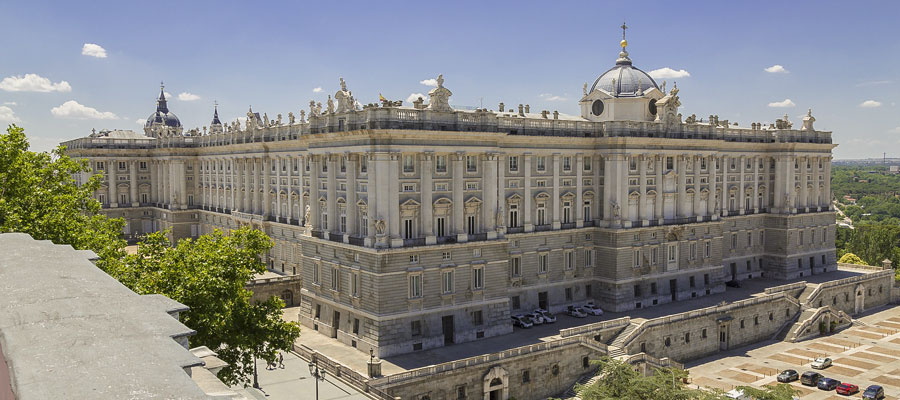
Royal palace of madrid
What to see at the Royal Palace in Madrid?
To give you a foretaste of the Royal Palace of Madrid here are in detail the most important rooms of the official residence of the kings of Spain.
The place of the armoury
The Armoury Square separates the Royal Palace from the Almuneda Cathedral. It is an ideal place to take pictures of the Royal Palace, and it is also from this square that you can enter the palace and start the visit.
During military graduations or events the Armoury Square is not accessible to allow the event to take place. If you are visiting the Royal Palace of Madrid we advise you to go to this square to start your visit and soak up the sublime royal decorations.
The main staircase
The main staircase of the Royal Palace has been designed to have a graceful and harmonious step.
This is possible thanks to the small spacing between each step making it very easy and pleasant to use.
Each step is carved from a single 5m long piece of Spanish marble. When you pass by this staircase take the time to look at the magnificent vault and its paintings which describe the Spanish monarchy of the 18th century. You will find many sculptures depicting royalty including two lions symbolizing power and Spain.
Room of Charles III or Mattia Gasparini
Charles III’s room is decorated in Rococo style from floor to ceiling. Very fashionable at the time of Charles III this joyful style represents the beauty of nature and oriental art.
The very difficult decoration was completed almost 50 years after the request. You will find on the floor a marble marquetry representing plants that you will find on the seats and the walls.
The room of Charles III is one of the most prestigious rooms of the royal palace with a very rich decoration and one of the most important clocks (shepherd’s clock) of the royal palace.
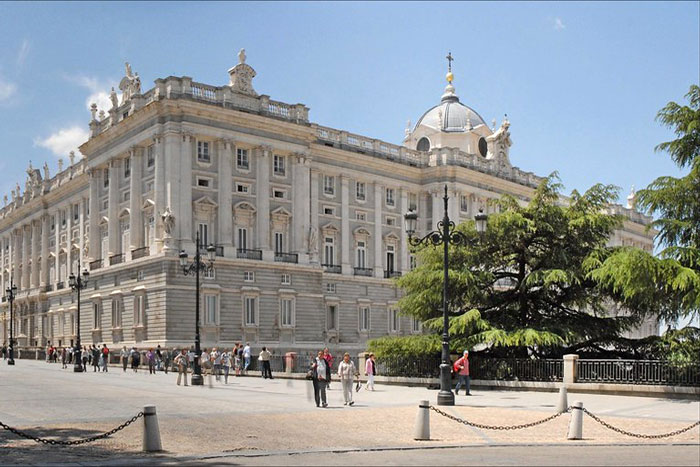
Royal palace of Madrid
The Royal Chapel
The chapel of the Royal Palace in Madrid is one of the most impressive rooms in the building, a real jewel you will discover a chapel with luxurious details and full of meaning.
To make the most of this room we recommend spending several minutes observing the details of the magnificent dome.
The Stradivarius Hall
This room is one of the most eagerly awaited in the Royal Palace in Madrid. Stadivarius pieces are presented, 2 violins a viola and a cello. These four instruments were acquired by the court in 1775, they were regularly used for concerts and are still used for exclusive events in the royal palace of Madrid.
This hall is much loved by music lovers from all over the world both for its decoration and the pieces on display.
The Throne Room
The king’s throne stands in a large room with red velvet walls and sumptuous decoration.
This room was completed in 1772 and the decoration has remained intact to the present day. Each decorative element is an allegory that symbolises the Spanish monarchy and its history.
It is interesting to be accompanied by a guide to be able to learn about the meaning of each element in this masterful room full of history.
The armoury and the royal kitchen
It is not possible to visit the entire palace (almost 3000 rooms) but you can visit the impressive armoury and the kitchen.
The armoury is located in the back on the right (when looking at the Almuneda Cathedral) of the main courtyard of the royal palace. For the kitchens we advise you to ask the staff of the royal palace whether they are open or not.
Visit the Royal Palace of Madrid with a historian guide
The Royal Palace in Madrid is one of the most beautiful palaces in Europe is one of the palaces that has seen the most kings and culture live within these walls.
The history of this building is very important to understand the evolution of the Spanish monarchy. Each room has a history and their decoration too.
Visiting it with a historian guide will give you a comfort in understanding the works and the meaning of the allegories present in the palace.
One of the great advantages of visiting the Royal Palace of Madrid with a guide and being able to spend more time in the rooms to appreciate its history and decoration.
You will learn how the kings used painters and artists to show its superiority and power.
The visit of the palace with a guide lasts almost 2 hours, very complete and rich in explanation it is an incomparable experience that awaits you.
Visit the Royal Palace of Madrid with Madrid Discovery
At Madrid Discovery we offer you a unique and luxurious experience in the Royal Palace of Madrid. Take a private tour of the palace with a historian guide and learn about the history of Spain and the Spanish kings.
Visiting the palace with Madrid Discovery is the assurance of a personalized and authentic visit. As soon as you book a tour, a personal advisor will take care of preparing your visit.
On the day of your visit your guide will pick you up directly at your hotel, transportation between the hotel and the palace is included in the price as well as fast entrance fees.
You won’t have to wait to get home and enjoy a royal visit.
Attend the changing of the guard at the Royal Palace in Madrid
Changing of the guard takes place on Wednesday and Saturday of each week (except for official ceremonies or unfavourable weather conditions). You will be able to attend the Changing of the Guard show every first Wednesday of the month (except January, August and September).
Visit the Royal Palace in Madrid with your company or on a school trip.
If you are planning to visit Madrid with your company for a seminar, team building or company trip, we will provide you with a “turnkey” offer to visit Madrid and the Royal Palace.
We work with quality partners who offer top quality services to meet your requirements and provide you with an experience worthy of your expectations.
We regularly welcome school students on a trip to Madrid and we are happy to organize visits to the Royal Palace of Madrid.
The educational aim of our teaching staff is reflected in the explanations given by our guides. We have developed visits to capture the attention of students and provide them with real added value to make their stay as beneficial as possible.
For more information about group visits to Madrid, the Royal Palace or the museums of Madrid, please contact us directly by email at info@madrid-discovery.com.
How do I get to the Royal Palace in Madrid?
It is very easy to reach the Royal Palace in Madrid, most hotels are less than 10 minutes walk from the palace and it will take you less than 15 minutes by taxi to get there from the most distant hotels.
The best option is to take a taxi to get dropped off right in front of the entrance.
If you wish to take a taxi you will have to use line 2 and exit at the Opera station, you will have to walk less than 5 min to get to the Royal Palace.
More information about the Royal Palace in Madrid
Madrid Royal Palace rates
- Adult rate: 13€.
- Reduced rates (under 16 and, large families, over 65s and students): 7€.
- Free for children under 5 years old
Opening hours of the Royal Palace in Madrid
- Monday to Sunday from 10am to 6pm between October and March
- Monday to Sunday from 10am to 8pm between April and September
- On public holidays, the palace closes at 3 p.m.
More information about the Royal Palace in Madrid
If you like to visit monuments and museums during your travels then this visit will be perfect, very pleasant to visit the Royal Palace of Madrid will not leave you indifferent.
To make the most of your stay we recommend you visit the Royal Palace of Madrid and then continue the visit with the Prado Museum and then visit the Reina Sofia Museum.
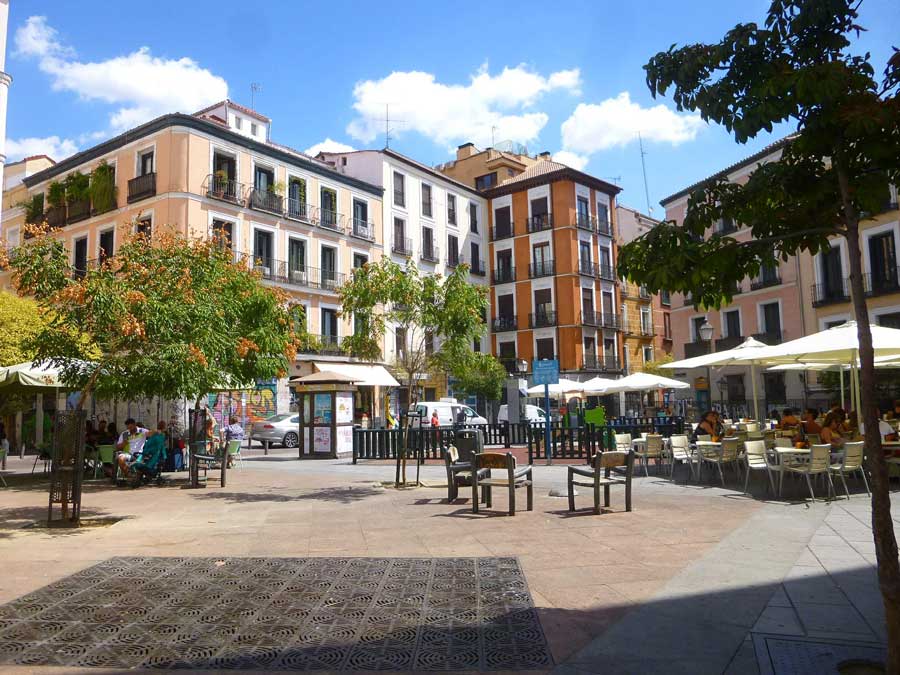
The malasana neighbourhood is one of the most popular places in Madrid, a place to live, shop or go out, where you can gather and have a good time with your family or friends.
Emblematic district of Madrid both by its history and by the different cultural movements that have emerged there, malasana neighborhood has become over time a unique and authentic neighborhood not to be missed during a stay in Madrid.
In love with Madrid and passionate about its history, we have decided to write this post to tell you more about this district so emblematic of our beautiful city Madrid.
You are probably wondering :
Why does malasana neighborhood have this name? Why is the 2 de mayo square so important? Who is Malasana? What to do in Madrid? Where to eat in Malasana? Where can I go shopping?
We hope that this guide to the malasana neighborhood will help you prepare your stay, if you liked it don’t hesitate to tell us on our social networks and share the article around you.
Malasana’s story
Before introducing you to the modern malasana neighborhood, it is interesting to start by telling you the history of this district. Discover the life of the alasana district right now to become a schoolteacher in the trendiest district of the capital.

malasana neighborhood
La movida and Malasana neighborhood
The movida is a cultural movement that followed Franco’s dictatorship in the 70’s, unique in all Europe it was at this time that Spain freed itself from its chains and discovered the world.
Malasana neighborhood was the cradle of this movement with famous bars and still famous for their parties and big parties.
The modern Malasana
The malasana neighborhood is the perfect place if you want to spend a shopping day in the capital.
After this section you will find a guide to spend an ideal day in Madrid.
Discover or go shopping in Madrid, or drink a cana, the rooftops of the neighborhood or the best restaurants in the city.
Shopping in Malasana
Once you’re in this beautiful neighborhood, you’ll be able to feel the hipster atmosphere.
Fashion in Spain is very present and you won’t be disappointed when you see the numerous thrift shops, in total you will find no less than 15.
Each one has a particular style, with pieces coming from the US, France or Spain. One of the most famous is the flamingo where you will be able to buy a lot of clothes and finally pay by weight. A concept that is very popular with Spaniards and that does not leave indifferent every traveller passing through the malasana neighborhood.
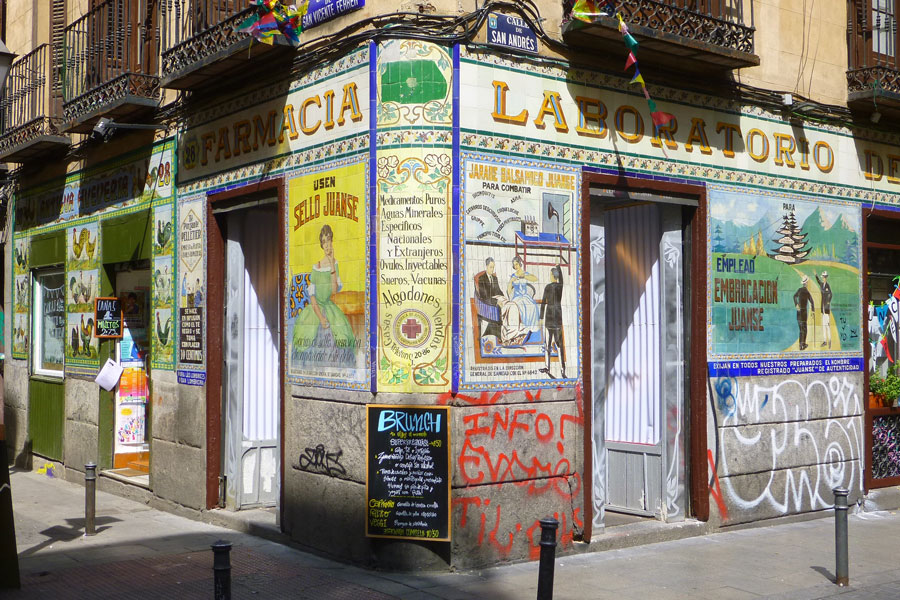
malasana neighborhood
drinking beer in the malasana neighborhood
Malasana neighborhood is also and above all a place where you can meet with friends to enjoy tapas around a cana. Spend a real moment in Spanish “tapar” from bar to bar.
You’ll find the best bars in the area in plaza del 2 de mayo where beers and glasses of wine are usually less than 2€.
A list to make your cana break a success:
La Bicicleta, A bar for bicycle lovers, atypical and warm, this bar will transport you in less than a few minutes in the Spanish atmosphere!
Ojala, If you have to choose a bar in malasana it will be this one. A bar with three different atmospheres, a terrace or in the sun, a flowerpot where you will eat between the plants and finally a travel atmosphere with a basement full of sand, enjoy a break with your feet in the sand!
Pepe botella, One of the mythical bars of Malasana, located near the Plaza del dos de mayo this bar has taken the nickname given to Napoleon’s brother “pepe botella”. This goes back to the time when Napoleon’s brother was governor of Madrid, he decided to make decrees on the sale of alcoholic beverages and was caricatured by the artists of the city that gave him this nickname. For the most curious we suggest you take a trip to the Museum of History of Madrid where you will find the original drawings of the caricatures of “pepe botella”.
Lunch and diner in the malasana neighborhood
Malasana neighborhood is also the place to enjoy tapas with friends and dine in small restaurants.
You will find a great diversity and will be able to taste a simple tapas to a Greek dish through a Mexican dish.
Here is a list of our good addresses:
Another great place to enjoy good food: Ojala, if you want to eat with your feet in the sand, on the terrace or in a greenhouse. A very popular place in Madrid and often sold out, especially when the sun makes its first appearances.
To taste many styles of cuisine you will find the market of St Anton. A delight for gourmets and foodies from all over the world.
The Fuencaral street will plunge you into a gustatory broom.
Our good address:
Lateral, present in several districts of Madrid, is a sure value in terms of tapas.
We recommend the pincho de tortilla! If you liked this restaurant we advise you to find the different restaurants in Madrid.
Saporem, a restaurant hidden by a rather banal facade, entry into a world where you will be cut off from the world, an atypical decoration awaits you and delicious dishes to enjoy with friends or family.
If you prefer Mexican food, we suggest you take a street tour where you will find a typical Mexican restaurant. Get into the atmosphere and taste a real michelada!
A restaurant not very touristy, but just as delicious, … this Japanese will make you travel through its thematic rooms, attention, if you want to eat there try to book in advance to have a table. The ramens are delicious !
Eating a hot dog on the go, a crazy street food style restaurant is waiting with their delicious perros calientes !
Malasana neighborhood & LGBT experience
The malasana neighborhood is located right next to the famous chueca neighborhood, where you will find many famous addresses of the LGBT community. If you want to have a list of gay experiences to do in Madrid don’t hesitate to take a look at our LGBT guide.
Going out and meeting people in the malasana neighborhood
Malasana is a party place. Party again, relive the movida and dive into the authentic Madrid during your stay. This is the bar not to be missed at a party in malasana.
La via lactea: a bar well known to Spaniards and famous for its concerts and the personalities who have frequented it.
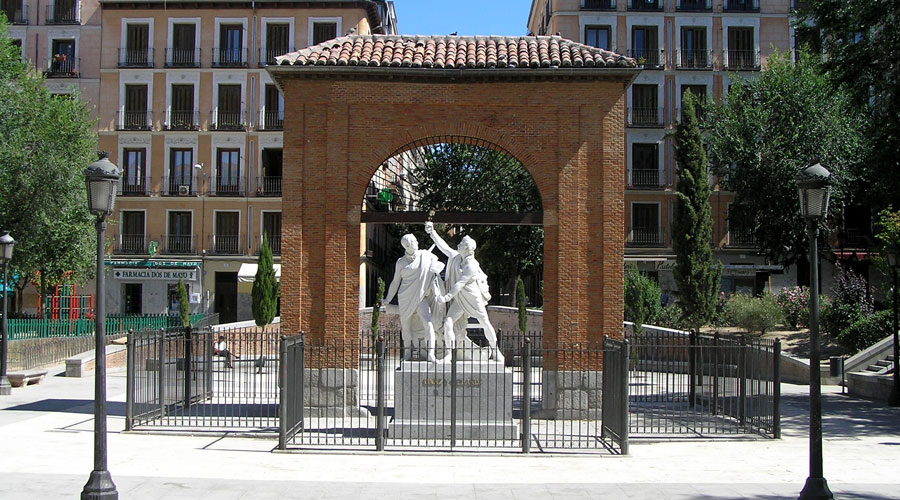
malasana neighbourhood
Our guide to spend a perfect afternoon in the district of malasana
Make the most of a sunny day to discover this beautiful neighbourhood and live to the Spanish rhythm.
A historic morning
Explore the Museum of Madrid where you will have the opportunity to learn more about the history of the city.
Enjoy some tapas and explore the neighbourhood from the plaza del 2 de mayo, from the plaza upwards and then head to fuencarral.
Take a lunch break in Saporem and enjoy delicious food.

Prado Museum
Discover a complete guide to the Prado Museum and plan your stay in Madrid in complete tranquillity.
Table of Contents
The Museo del Prado is one of the museums to visit during your stay in Madrid. Located on the Paseo del arte in the city centre it is part of the famous Golden Triangle of Art along with the Reina Sofia Museum and the Thyssen Bornemisza Museum.
The Museo del Prado is known worldwide for its works of art belonging to Spanish monarchs.
Works by Goya, Velazquez and Bosch commissioned by the kings are on display as well as a large number of paintings by European artists.
When to visit the Prado Museum? Where is the museum located? How much time is it worth to visit the Museo del Prado? Do we need to take a historian guide? How much does the entrance to the Prado cost?
In order to answer the questions you need to ask yourself about your visit to the Museo del Prado we have prepared a complete article about the museum and its visit. Discover now how to make your visit a success and not miss the greatest works of art in the museum.
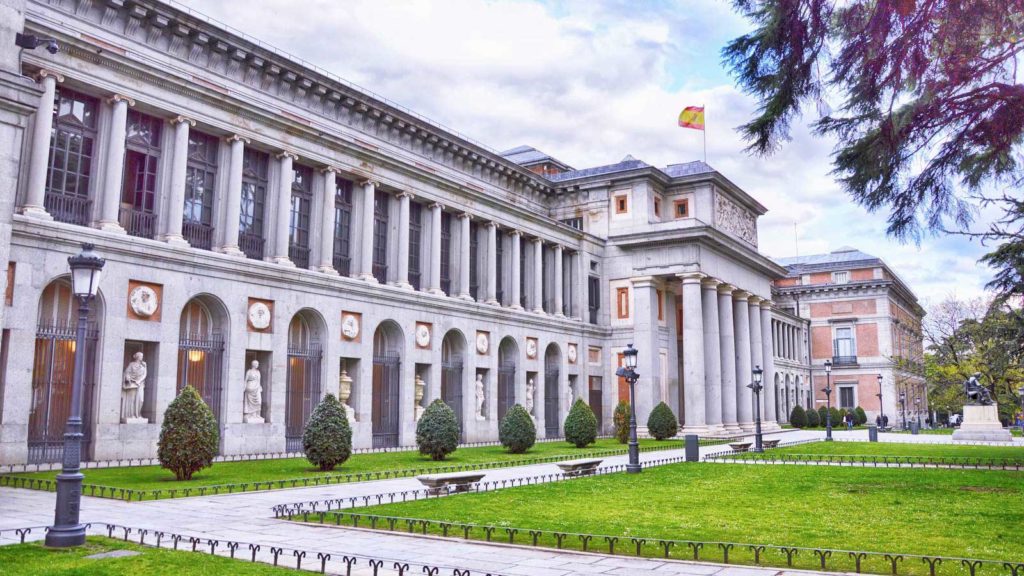
Museo del Prado
Visit the Prado Museum with a historian guide
As many of you still book our private tour of the Prado Museum, your feedback on the visits is very positive and we are delighted that your experience has been a success.
Visiting a museum like the Prado Museum without the explanations of a historian guide can make you miss the meaning and history of most of the works.
If you want to visit the Prado Museum, it is because you are sensitive to art and want to know the history of the works and the history of the painters.
At Madrid Discovery we have developed private tours of the museum with English speaking historian guides, during your visit you will study about 15 important works of art in the museum.
Your guide will introduce you to the life of the painters and their relationship with the court and society, as well as the rivalries between them.
In order to offer you a complete service, we take care of the purchase of the tickets as well as the transport from your hotel to the Prado Museum. Our mission is to make you live a unique and enriching experience on the history of art. You will be accompanied by a French-speaking guide and will benefit from quick entries so that you don’t have to wait long minutes in the queue (included in the price).
In order to personalize your experience as much as possible, you can ask your English-speaking historian guide to visit a particular part of the museum.
Satisfy your desire for culture and discover the unexpected with Madrid Discovery.
If you visit the Prado Museum with your family and young children or teenagers it will be a good way to capture their attention and avoid them getting bored, our guides are used to working with a very young audience and will capture their attention.
Why visit it with Madrid Discovery?
Unlike the majority of the visits you will find at the Museo del Prado our tours are entirely private and in your language. At Madrid Discovery we work day by day to offer completely personalized experiences thanks to our network of qualified and professional partners.
Being transparent with our clients is a priority, so once you make a reservation on our website you will not have to pay anything, we do not ask you to pay cash or buy the tickets yourself.
Included in the price is a series of exclusive services such as the purchase of fast tickets, the departure of your visit from your hotel, the journey from your hotel to the museum and a dedicated customer service that can be contacted at any time.
Can’t make the tour? Had to cancel your stay in Madrid? Don’t worry, contact customer service for a full refund of your purchase*.
* Refund conditions are indicated in the general terms and conditions of sale.
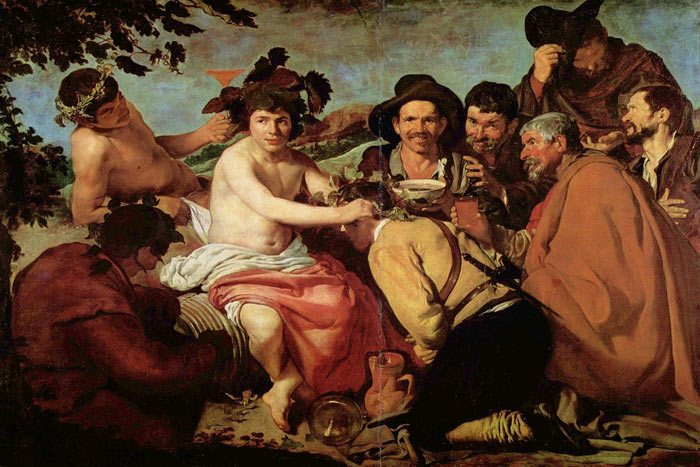
Museo del Prado
Visiting the Prado Museum with your company
The Museo del Prado will be an ideal visit for an afternoon of team building, many companies contact us to organize a visit during their trip to Madrid and we are happy to offer them our experiences.
We have dedicated products for companies, these are “turnkey” visits so you don’t have to worry about the organization.
For more information about group visits or team-building, please contact us directly by e-mail.

Museo del Prado
Visit the museum without a guide
If you wish to visit the Prado Museum without a historian guide then this part will help you to organize the visit. The Prado Museum is quite complex and requires some organization to visit it.
Composed of three floors and more than 1200 works, the Prado Museum is spread over 45 km2, it is very easy to get lost without really enjoying the visit. Its size and the large number of works can make the visit very tiring and most visitors visiting it alone do not make the most of their experience due to a lack of explanations.
Before returning home you will have to buy your ticket at the ticket office, if you come to visit the Prado Museum during the high season it may take more than 30 minutes to get in.
To avoid wasting too much time we advise you to come and visit it at off-peak times. We will detail the rates and times below.
What to see at the Prado Museum
Once inside the Museo del Prado you will find yourself on level 0, a very spacious level with a luggage locker, toilets, a bookshop and a cafeteria. It is also on level 0 that you will find the museum’s temporary exhibitions.
If you have no idea how to start your visit to the Museo del Prado we advise you to ask the information stand for advice, they will help you along the way. The museum offers flyers with the high-lights to see, to give you an idea it takes 2 hours to see 20/25 paintings (quick passage without explanations).
The three levels of the Prado Museum
- Level 0 of the Prado Museum: Jeronimos building and Villanueva building / Temporary exhibitions.
- Level 1 of the Prado Museum: Spanish / German / Italian paintings / drawings.
- Level 2 of the Prado Museum: sculptures / 18th and 19th century Spanish paintings
The black paintings of Francisco de Goya are located on level 0 room 67, you will find a large number of works from his period known as the “black paintings”.
The meninas of Velázquez are located on the 1st floor in room 12.
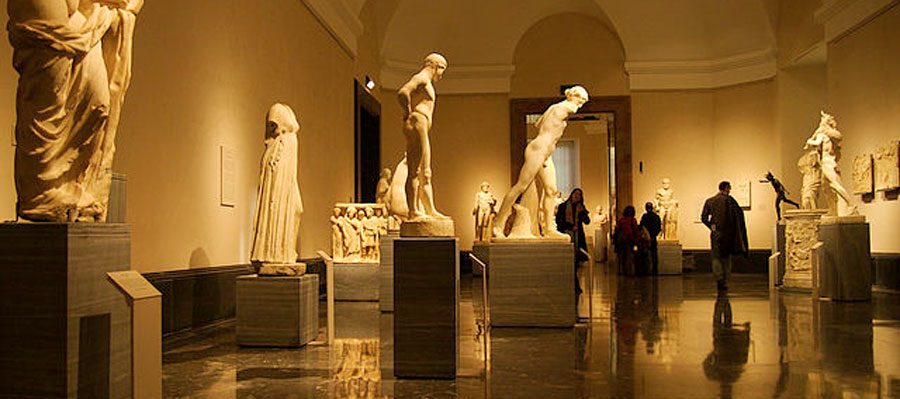
Museo del Prado
3 great painters present at the Museo del Prado
Francisco de Goya
Francisco de Goya is a Spanish painter of the 18th century, he made many trips to Italy to cultivate himself and learn new painting techniques. He is famous for his paintings of the royal family, 2 de mayo, black paintings and much more. Very represented in the Prado museum you will have the opportunity to discover his career.
Diego de Velazquez
Diego de Velazquez is a Spanish Baroque painter, famous for his paintings he is also one of the most represented painters in the Prado Museum. You will find one of his most famous paintings on level 1: The Meninas.
Bosch
Jerome Bosch is a Dutch painter of the Flemish Primitive Movement. The Prado Museum exhibits various works including the Garden of Delights, a painting used to teach religion to the young kings of Spain.
During your visit to the Prado Museum you will discover a large number of painters and works. Visit the Prado with an English-speaking guide to know the details of each work.
10 of the works that the Museo del Prado advises to see
Here is a very brief list of the works that you can admire at the Prado Museum.
- Sala 56A EL BOSCO El jardín de las delicias
- Sala 56A EL BOSCO La mesa de los pecados capitales
- Sala 25 TINTORETTO El Lavatorio
- Sala 58 VAN DER WEYDEN El Descendimiento
- Sala 56B FRA ANGELICO La Anunciación
- Sala 55B DURERO Autorretrato
- Sala 9A VELÁZQUEZ Las lanzas o La rendición de Breda
- Sala 12 VELÁZQUEZ Las meninas
- Sala 29 RUBENS Las tres Gracias
- Sala 32 GOYA La familia de Carlos IV
We advise you to end your visit by passing by the room dedicated to the black paintings of Goya, you will find not far from this room one of the most famous paintings of Goya, “el dos de mayo” (the back of mayo).
Where the Prado Museum is located
The Museo del Prado is located in front of the Thyssen and Bornemisza Museum, if you sleep at the Ritz, Westin palace or NH paseo del Prado you will only have to cross the paseo del arte to get there.
If you come to spend the day in Madrid and take the train to the capital then you will have to walk a few minutes to get to the Prado Museum.
The Atocha train station is located right in front of the Reina Sofia Museum and very close to the Prado Museum.
You will find the Retiro Park behind the Prado Museum, once your visit is over it will be a good opportunity to take a walk there.
If you decide to go to the Museo del Prado by metro then we suggest you take line 2 and stop at banco de espana, it will take you a little less than 10 minutes to walk there.
How much does admission to the Museo del Prado cost?
Admission to the Prado Museum is 15€. If you are over 65 years old then you will get a discount.
Subject to proof, persons meeting the following conditions will be admitted free of charge:
- Under 18 years of age
- Student from 18 to 25 years old
- Journalists, people with reduced mobility, people out of work.
Schedules of the museo del Prado
The Museo del Prado opens every day at 10:00 am, it is also one of the busiest times of the day, you may have to wait 30-40 mins before you can enter the museum.
The solution is either to come earlier to get a good seat in the queue or to come later when the 10:00 am visitors have finished visiting the museum.
We advise our customers to book their visit for 3:00 pm, this is a slow time and the number of visitors is very low.
Monday to Saturday from 10am to 8pm
Sundays and holidays from 10 am to 7 pm
The Museo del Prado is closed on the following days:
January 1st
May 1st
December 25th
Visit the Prado Museum for free
It is possible to visit the Museo del Prado free of charge, for this you will have to wait for the end of the day slot between 18h-20h on weekdays and 17h-19h on weekends and public holidays. If you have any doubts, do not hesitate to contact the Museo del Prado directly for more information.
You can also visit the Museo del Prado free of charge on Prado’s birthday on 19 November and on 18 May for International Museum Day.
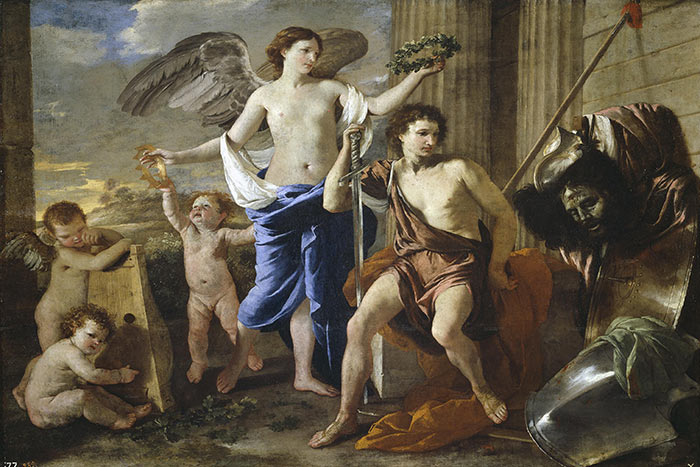
Museo del Prado
Is it interesting to visit the museum during this time?
Visiting the Prado Museum at this time of the year can be interesting if you have a small budget and want to visit Madrid in an economical way. However, in order to get in, you will have to start waiting from 5:00 pm or even 4:30 pm on busy days. To be sure to get in during the free schedule some people start waiting very early.
In general the number of people who enter for free is quite high and you won’t be able to visit the museum in the best conditions. To sum up, visiting the Prado Museum for free may be interesting, but requires some sacrifice of time and comfort.


Historic Centre of Madrid – Royal Palace of Madrid – Plaza Mayor
Table of Contents
For a visit to the historic centre of Madrid we recommend you to visit :
- The Royal Palace in Madrid
- The Cathedral of the Almuneda
- La plaza mayor
- The mercado de san Miguel
- La puerta del Sol
- The Latina district
- Eating at the Sobrino de Botin
One of the advantages of Madrid is that despite its very large size it is possible to visit the historic centre of the city on foot without wasting time on public transport.
The historic centre of Madrid is big enough to spend a morning during a 2 or 3 day stay in the capital.
The historic centre of Madrid is located in the current city centre, many hotels are in this area and it will be easy for you to find the one that best suits your needs.
If you are visiting Madrid in 3 days we advise you to stay in one of the hotels located near the Royal Palace.
For more information about the different hotels in the city don’t hesitate to consult our Madrid hotel guide, where you will find the best addresses, our opinions and a list of more than 10 hotels where you can stay or sleep in the capital.
In this article you will find the essential information about what to visit during your stay in Madrid. If you are wondering what to do in Madrid and what to visit during a stay of 2 or 3 days then you are at the right place.
Do not hesitate to contact us with any questions you may have about your stay, we will be happy to answer them.
The historic centre of Madrid offers a wide range of cultural activities and many places to visit, which is why we’ve included a full article to cover the subject and help you prepare for your future stay.
Don’t hesitate to book a city tour of Madrid so that you don’t lose time during your stay and visit the best of the city.
Not to be missed: the ideal itinerary in the historical centre of Madrid (at the end of the article) during a stay in Madrid.
The heart of the historic centre of Madrid: the Royal Palace of Madrid
The Royal Palace in Madrid is one of the most beautiful and grand palaces in Europe and is one of the monuments of the city to visit during your stay.
The palace represents the historic centre of Madrid, it is from this point that the city has grown to currently cover more than 600 km2 or almost 6 times Paris!
The palace opens to the public from 10am, if you want to live an exclusive moment it is possible to start the visit from 9am, but only with an official guide. For more information about this service do not hesitate to contact us and take a tour on our website, we will organize you a unique and authentic visit of the royal palace with a English-speaking guide.
Once inside the royal palace you will have the opportunity to visit it and to plunge back into the life of the monarchs. Here is a list of the main rooms you will be able to see:
The grand palace staircase.
You will discover the Column Lounge.
The bedroom of Charles 3.
The porcelain cabinet.
The Gala dining room.
The royal chapel.
The throne room.
The visit doesn’t stop there, if you have time is that they are open then you can access the royal armoury and the royal kitchen.
Don’t hesitate to ask a member of the staff if it is possible to visit them.
During your visit you will pass by the Stradivarius room, you will find an impressive collection of original Stradivarius as well as the scepter and the royal crown.
If you are interested in the royal palace and the history of Madrid do not hesitate to read our article dedicated to this monument and the history of the monarchs who lived there.
-> Our article on the Royal Palace of Madrid
If you are visiting the historic centre of Madrid we recommend you to take a tour around the Opera Square in front of the Royal Palace of Madrid. The building is open to the public and you will have a great view of the palace from the Opera Balcony.

Historic Centre of Madrid – Opera Madrid
The Cathedral of the Historic Centre of Madrid: L’Almuneda
Located in front of the Royal Palace and separated by the Plaza de la Armería the Almudena Cathedral will surprise you with its magnificent statues.
It is a relatively young cathedral built in the 20th century with different styles (neoclassical on the outside and neo gothic on the inside).
It is important to note that it is the only Spanish cathedral to be consecrated by a pope.
It was during a trip to Spain that Pope John Paul 2 consecrated it in 1993.
Located in downtown Madrid it is also one of the monuments to visit. Access is free, but a donation is required. You will discover a large nave as well as a magnificent dome at the crossing of the transept.
The crypt of the Almuneda Cathedral
We advise you to visit this neo-Romanesque style crypt, under the Almudena Cathedral. You will have to go around the cathedral on the left to get to the entrance of this unique place.
The crypt of the Almudena is one of the largest in Spain, generally not much frequented you will be pleasantly surprised by this jewel.
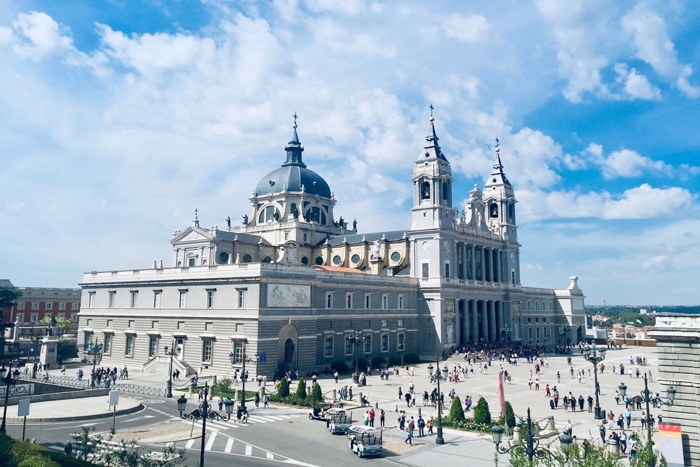
Historic Centre of Madrid – Crypt of the Almuneda Cathedral
The palace gardens: El campo del moro
If you have the opportunity to visit the historic centre of Madrid between March and October then we recommend you to take a walk in the beautiful Campo del Moro Park.
This English style garden is full of flowers. El campo del moro is ideal to rest after a visit to the royal palace and take your best pictures.
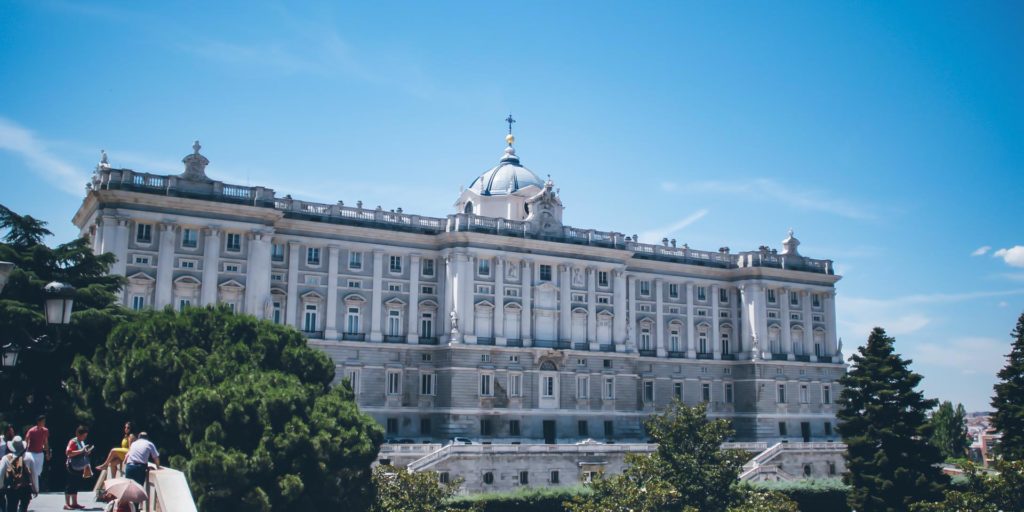
Historic Centre of Madrid – Royal Palace of Madrid – Campo del moro
The Basilica of San Francisco
This basilica is located not far from the Latina district and very close to the Almudena Cathedral. It is the most beautiful basilica in Madrid that you can visit.
You’ll have to cross the Segovia viaduct that connects the Royal Palace and Las Vistillas Park.
This viaduct became famous thanks to its appearance in Pedro Almodovar’s films like Matador or The Passenger Lovers.
You will find this basilica on your right after passing the viaduct. It is not very well known by tourists and is rather frequented by locals, it was our favorite when we entered it, with a neoclassical style you will find works of Goya.
It has a very large dome which is one of the largest in Europe after St. Peter’s Basilica or the Cathedral of Santa Maria in Florence. This basilica is one of the most beautiful in the historic center of Madrid.
Take advantage of your visit to the Royal Palace to take a tour of this unique place.
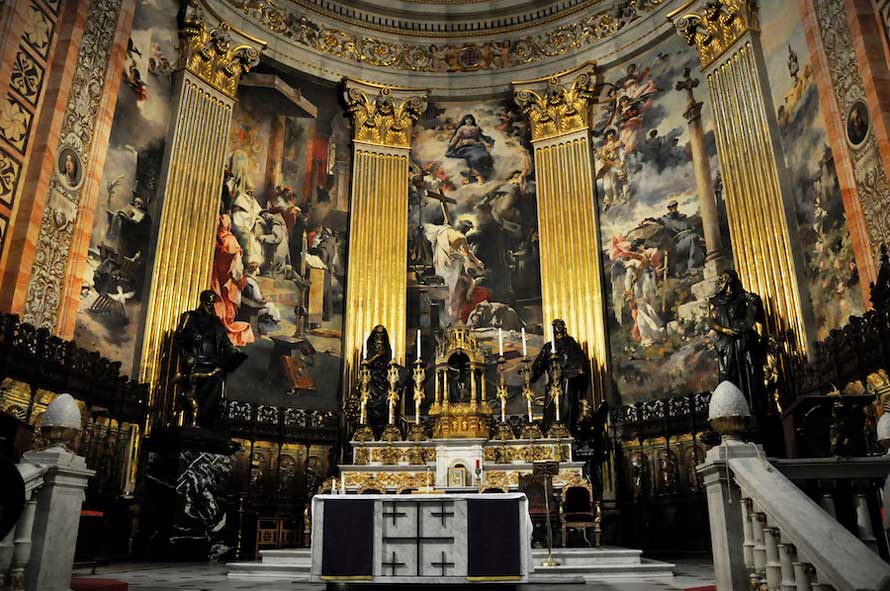
aHistoric Centre of Madrid – Basilica Madrid
The historical square of Madrid: Plaza Mayor
Madrid is made up of different squares that have evolved over time.
The plaza mayor which is part of the historic center of Madrid and also one of the most historic squares, it delineated one of the boundaries of the city in the 16th century.
Originally equipped with a hall it was the city’s market. It was three big fires that shaped it and changed its appearance.
You will find the statue of Philip 3 in the centre. Stroll under the arcades to admire the architecture of this magnificent place.
The Plaza Mayor is one of the most touristic places of the city, not to fall into the trap here is a list of authentic addresses of the place.
Have a drink at the café at: Al Fresco.
Eat a squid sandwich at the bar La Ideal.
Eat a traditional dish at the restaurant Gustos.
Visit Madrid in winter to see the famous Christmas market!

Historic Centre of Madrid – Plaza mayor Madrid
The historic market of Madrid: Mercado de San Miguel
You have probably already heard about the San Miguel market from a friend of yours who has been to Madrid or when reporting on the Spanish capital.
Located in the historic centre of Madrid the San Miguel market is a must for lovers of tapas and Spanish gastronomy.
It’s also a unique architectural work of art, made of glass and a metal structure that makes it an atypical and pleasant building to visit.
It’s usually a stop on our private tours of the city, it’s the ideal place to recharge your batteries after a visit to the royal palace.
Known all over the world by the presence of prestigious Spanish and foreign chefs, you will have the opportunity to taste tapas from all over Spain without forgetting a glass of Sangria or a caña.
This is what awaits you:
Joan Roca artisanal ice cream (3 Michelin stars).
Pellas de Rodrigo de la Calle (1 Michelin star).
Basque gastronomy with Amaiketako.
Typical Madrid dish from Casa Lhardy.
If you want to taste real Mexican tacos you will find Roberto Ruiz (1 Michelin star).
The mercado san Miguel is open every day from 10am to midnight and until 1am on Saturdays. You will be able to enjoy tapas every hour of the day. If you wish to enjoy the Spanish atmosphere we advise you to come and eat around 11am to enjoy a unique moment with your family or friends.
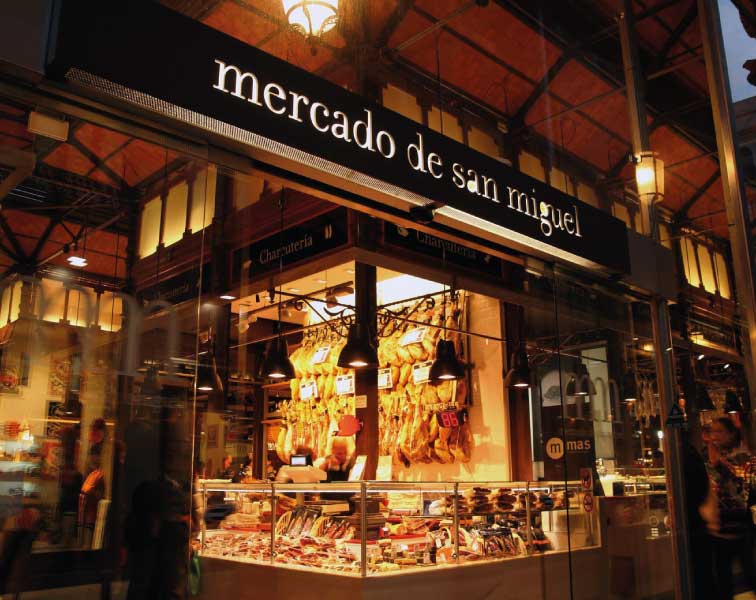
Historic Centre of Madrid – Mercado de Madrid San Miguel
Historic street of Madrid: Calle Mayor
Main axis of the historic center of Madrid this street starts at the foot of the Almudena Cathedral to reach the puerta del sol. Here you will find many restaurants and tourist shops.
You will be able to admire the modernist architecture of the buildings while strolling through its atypical little streets in the historic centre of Madrid. You will find famous historical buildings such as :
Casa de Calderón.
Joyeros de Mayor.
Miradores de chaflán.
Sobrino de Botin
One of the most popular addresses in the capital is the Sobrino de Botin, a typical restaurant serving traditional Spanish dishes, the oldest restaurant in the world opened in 1725.
It is on 4 floors that this 16th century style restaurant with low ceilings and antique period decoration is located.
Its characteristic wooden façade makes this restaurant a unique place where you can taste many traditional dishes such as cocido or lentils.
To eat there nothing simpler, you can go there and wait half an hour to have a table. To avoid this and to be sure to have a table quickly we advise you to book via their website, they have an online reservation system.
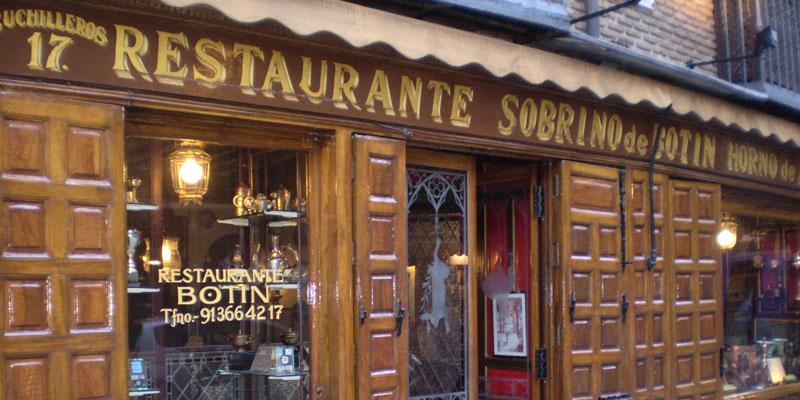
Historic Center of Madrid – Botin restaurant Madrid
Puerta del sol
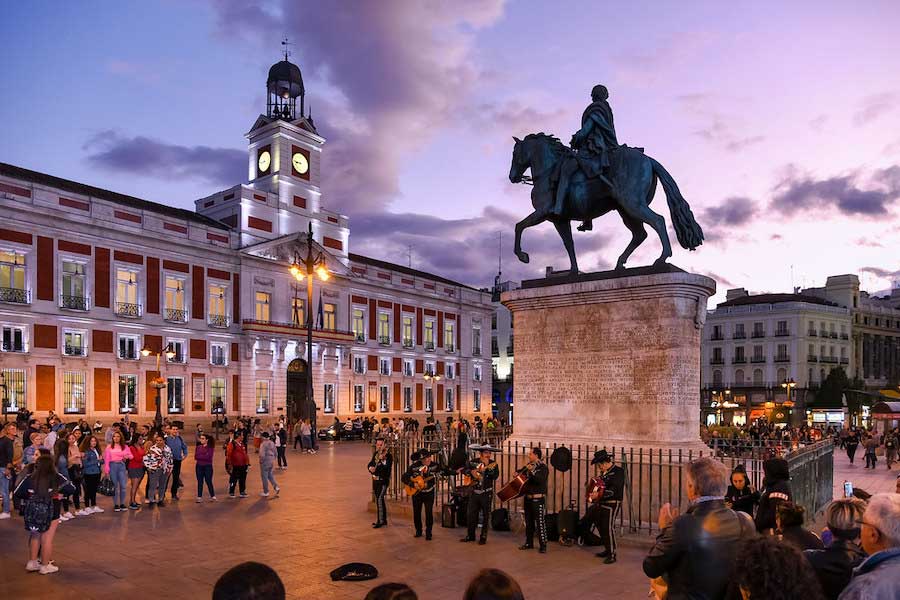
Historic Centre of Madrid – Puerta del Sol
The Puerta del sol, located in the historic centre of Madrid is the central square of the city, this is where many events take place such as the New Year, the 15 M, events and political demonstrations.
You will also find the 0 kilometer of Spain and the statue of the bear and the strawberry tree, emblem of the city.
La puerta del sol is almost entirely pedestrian, but it was not in its infancy.
Real nerve centre of the capital it is very well connected with Callao, Plaza Santa Ana, Plaza Mayor, the Madrid Opera or the Paseo del Prado with the famous Prado Museum, Thyssen and Reina Sofia.
La Latina aera
A visit to the historic centre of Madrid is not limited to the main monuments of Spanish history.
The Latina quarter is an integral part of Madrid’s history and will surely be part of your itinerary on your first visit to Madrid.
You should know that this neighborhood is built on the ruins of an ancient medieval Moorish fort. You will find a very atypical architecture with small streets that wind between the buildings. It is interesting to compare the structure of this neighborhood with the modern Salamanca neighborhood where the streets are straight.
Real district dedicated to shopping, discover our article on the Salamanca district with our good shopping and lifestyle addresses.
You will find many churches such as the church of San Pedro el Real or the basilica of Saint Francis the Great that we mentioned earlier.
La Latina is a very lively neighbourhood where Spaniards like to meet on Sundays to go hunting at the Rastro market, a real attraction in the historic centre of Madrid.
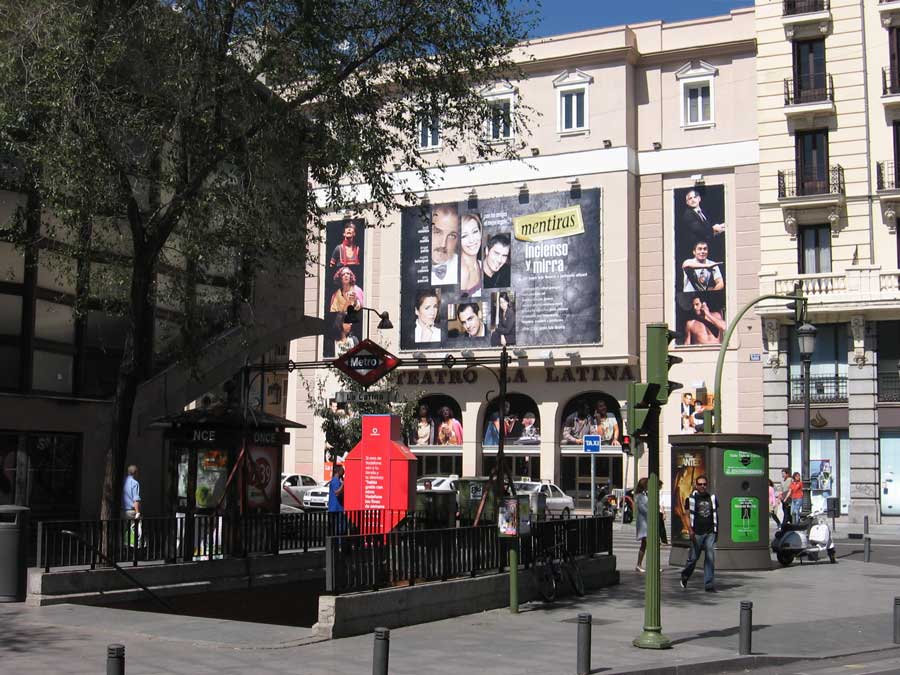
Historic Centre of Madrid – La Latina aera
The Cava Baja and the Cava Alta
The cava baja and the cava alta are two very lively streets in the historic centre of Madrid.
Rich in history, they have shaped the Latina quarter and are the ideal place to eat tapas and meet up with friends. With an older and calmer style, another atmosphere awaits you.
Make the most of your stay in Madrid to live both atmospheres.
You will find many bars in the cava Baja, the animation is greater in the evenings. The cava alta is less lively, but very nice to see with its many facades and tile shopfronts typical of the historic centre of Madrid.

Historic Centre of Madrid – Calle cava alta Madrid
The Cebada market
Very well known market for locals and visitors you will find fresh products, ideal to bring Spanish ham home. Take advantage of a Sunday to visit this typical place and enjoy some tapas on the terrace.
The Rastro Market
Located in the historic centre of Madrid, the Rastro market is open every weekend and on public holidays.
It is a paradise for antique and second-hand goods dealers, where you can find antique paintings, antiques, antiques and much more.
Always remember to negotiate prices, the Rastro’s sellers are rather conciliatory and accept your offers.
You will find a main street where many sellers offer you new products typical of the markets, if you want to hunt the best is to go into the small shops between the main avenues.
One area of the market is dedicated to picture frames and another to fripe.
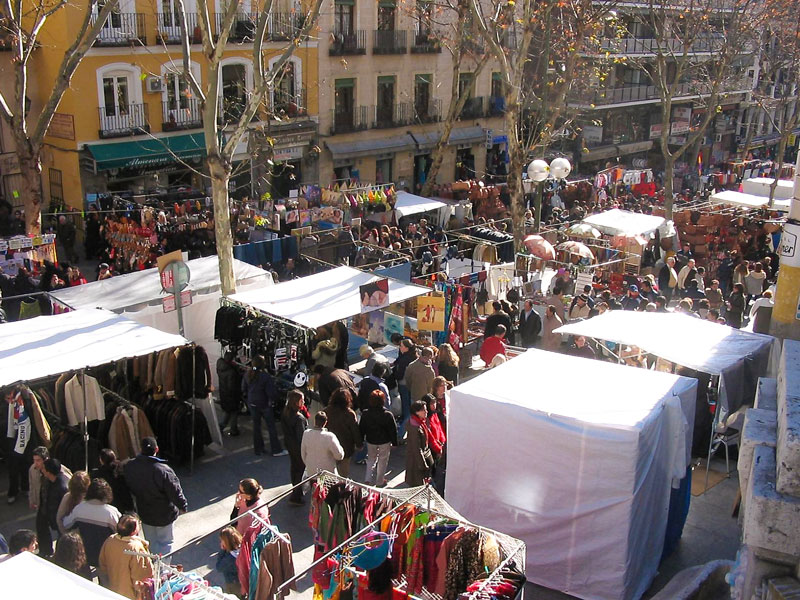
Historic Centre of Madrid – Rastro Market
What to do in Madrid in 2, 3 or 4 days?
What to do in Madrid? How long does it take to visit Madrid? What to do in Madrid in 3 three days?
What to do in Madrid in 2 days? How to visit the historical center of Madrid?
In order to make it easier for you, we have prepared a typical itinerary to discover the historic centre of Madrid in one day.
The perfect itinerary for a day in the historic centre of Madrid
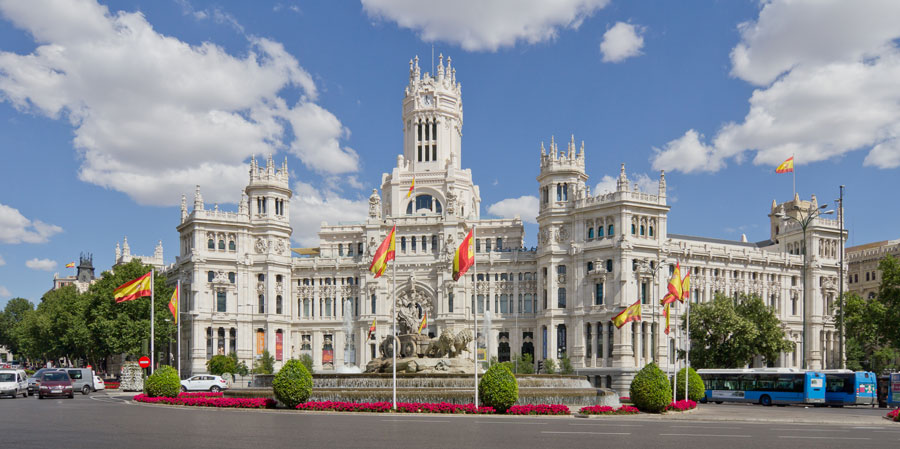
Historic Centre of Madrid – what to do in Madrid in 2 days
Whether it’s your first visit to Madrid or your tenth, you will be left out of this beautiful city. If you are planning your trip to Madrid this is the ideal day to discover the historical center of the city:
Morning
Visit to the Royal Palace of Madrid – We advise you to visit it with a guide, it will be more comfortable and you won’t have to worry about the organization.
If you are visiting the Royal Palace alone then we advise you to get there by 9:30am so you don’t have to wait too long.
Visit to the Almudena Cathedral (optional the crypt) – Once you have finished visiting the Royal Palace go to the Almudena Cathedral to visit it. It will take you no more than 25 minutes. If you have time you can visit the crypt of the Almudena Cathedral.
Time for tapas!
Once these two monuments have been visited, it’s time to leave for the San Miguel market to enjoy some tapas and regain your strength. You can stay there for 1 hour while you take a walk and enjoy some tapas.
Once the market is over, go to the Plaza Mayor and Puerta del sol, stroll from square to square and discover the secrets of these squares.
Lunch
Direction plaza santa Ana for lunch. We advise you to set yourself on Spanish time (lunch at 14:00 / 14:30) to make the most of your stay. You will find many restaurants on this beautiful square.
Once your meal is finished it is time to discover the district of the Latina is to stroll through the streets of the district. Pass by the calle mayor to find the district of the latina. Don’t forget to take a picture in front of one of the oldest restaurants in the world the Sobrino de Botin.
The snack
Take advantage of your stay in Madrid to taste churros con chocolate in one of the most famous restaurants: San Gines located in the historical center of Madrid between Callao and Opera (see district at the beginning of the article).
Your day of discovering the historic centre of Madrid is now over, take advantage of the Gran Via to do some shopping or enjoy a fresh cana in one of the bars in the area.
If you come across this article “the historic centre of Madrid” while preparing your stay in Madrid and you are wondering the following questions: What to visit in Madrid? What to visit in Madrid in 2 days? What are the best museums in Madrid? Where to eat in Madrid?

Stay in Madrid – weekend trip to Madrid
In order to help you prepare your stay in Madrid, we have put together a complete guide to the city.
Find out how to easily get to the capital, where to stay and the must-see places to visit. We also give you some tips on how to enjoy the typical food of the country.
Presentation of the Capital
Before introducing you to the city’s must-see attractions, it is imperative that you get an in-depth introduction to the Spanish capital for a successful stay in Madrid.
As mentioned before, Madrid is the capital of Spain, located in the heart of the country in the autonomous community of Madrid and has a population of over 6.6 million people.
A city increasingly appreciated by tourists from all over the world, it is known for illustrating the culture and history of Spain. The language spoken here is Spanish and the currency is the Euro.
Madrid is one of the European cities suitable for weekend breaks and short stays of 4 days or less. There are many hotels in Madrid that offer low rates for this type of stay, below in the article you will find different types of establishments ranging from cheap Madrid hotels to the city’s palaces.
Many of you ask us: What to do in Madrid during a 4-day stay? How many days to visit Madrid?
For more details about things to do and see in the capital don’t hesitate to take a tour on our blog and especially on our guide “visiting Madrid“. You will also find an article about hotels in the city and restaurants in Madrid so that you can prepare your stay in Madrid.
Do they speak English in Madrid?
You may be wondering: is Spanish the only language spoken in Madrid?
Sorry to disappoint you but the answer is yes! Even if the locals and shopkeepers are used to welcoming English tourists, in Madrid nobody speaks English for all that.
But don’t worry, Spanish remains a language easy to understand. If you wish to visit the museums and the city, we advise you to hire an English-speaking guide for more comfort during your stay in Madrid.
The hotel staff speaks several languages and will answer your questions.

Where to stay in Madrid for a weekend / stay in Madrid
Practical information for your stay in Madrid
In order to best prepare yourself for your stay in Madrid it is important to understand the daily life of the people of Madrid and their different habits from those of its European neighbours.
Here we will give you some practical information before your departure so that you will not be surprised during your stay in Madrid.
Many Spaniards take a nap in the early afternoon, which can be surprising since shops are closed at this time of day, but this is not the case in the capital.
Indeed, this habit is especially adopted in the southern regions of Spain where the temperatures between noon and 4pm are unbearable!
Spain has no time difference with some countries in Europe, so no jet lag is guaranteed if you travel from a country that has the same time!
If you travel from USA then you will have a time difference from +6h to + 9h. The jet lag can be difficult to fight so we suggest you to take a rest to your hôtel before starting to visit the city.
If you travel from Asia and Australia the you will have a time difference from – 6h to – 9h.
You will also need adapters since the plugs are European type.
Other essential information: the country code is +34.
I was telling you about the translators earlier to facilitate communication, but without Internet, no translator!
Rest assured that Spain is a country very well equipped in terms of mobile phone network with operators such as Orange, O2 or Vodafone. You can find a pre paid sim for cheap at the airport or in the shops of the city, it will be very usefull during your stay in Madrid. We wrote an article about the prepaid sim card to travel in Spain. Do not hesitate to check it on our blog.
In addition, many free Wi-Fi networks are available in the city, ideal for a cheap stay in Spain without any extra charge.
We recommend here some very practical clothes which will be indispensable during your stay in Madrid. First of all, even if the city has a good public transport network, take good walking shoes with you, also think about taking a hat or a cap especially in summer with of course your best pair of sunglasses.
If you are travelling during the sales then you will have the opportunity to shop and take advantage of very interesting prices. We therefore advise you not to overload your suitcase and take advantage of your stay in Madrid to do some shopping.
Make sure you bring comfortable clothes so that you are comfortable during your visits, but don’t neglect elegant outfits for going out in the evenings to restaurants. Ladies always bring a pair of high heels with you and your best summer dresses.
Also consider a swimsuit if you feel like taking a dip in one of the pools offered by the city’s rooftops.
If you’re interested, check out our Madrid rooftops guide to make sure you don’t miss out on any of the trendy spots during your stay in Madrid.
Finally, don’t skimp on sunscreen!

Short stay in Madrid
The cost of living in Spain, how to prepare your stay in Madrid
The cost of living in Spain is much lower than in other European countries, but of course the amount of money you spend on your trip depends on your desires and the type of travel you choose, whether it is economical or luxurious.
The price of a night in the capital can vary between 20€ and up to 250€ (22 US$ to 280 US$)
The food is generally much cheaper than in other European countires as far as tapas or beers are concerned, but of course the amount can quickly increase if you want a dish from a typical and reputable restaurant or if you want to dine in a gastronomic restaurant, with prices reaching 250€ (280 US$) per menu. The city’s markets are a good way to eat local and cheap.
Public transport is also much cheaper with a metro ticket at 1.50€ (1,68 US$) and a train ticket for a long journey of 1h40 starting at 5€ (5,61 US$).
Clothes are also much cheaper, which is a good bargain at Zara’s for example.
Sightseeing activities such as private visits to the Prado, the Reina Sofia or the Royal Palace have a price, however visiting a historical monument with a private guide in a confidential way is one of the best activities to do during your stay in Madrid.
What’s the climate like in Madrid?
In Madrid, the climate is mild in spring but the heat is felt from July onwards and becomes extremely intense in August and then becomes very pleasant again at the beginning of September.
Note that it rarely rains more than two days which will make your stay in Madrid very pleasant.
Winters are cold and dry, so it is very rare to find snow.

stay Madrid – climate
When to organize a stay in Madrid?
You’re probably wondering when to go to Madrid? Which season is best? Here is some information that will help you plan a successful stay in Madrid.
In the capital, the tourist season usually starts in early March to admire the flowers blooming in spring, especially in the Quinta de los Molinos park with its famous almond trees and Retiro park with its flowering rose bushes.
The tourist activity continues until November when the temperatures are still very appreciable!
The months of July and August are very hot but allow you to enjoy long evenings outdoors. However, these two months are quieter and it is during this period that people from Madrid go on holiday, so it is less crowded.
If you are planning to stay in Madrid for a few days or a weekend then the ideal time would be between March and June and then September and November.
This is when you will have the perfect time to visit Madrid.
How to get to Madrid?
There are various ways to get to Spain during a stay in Madrid. Some are cheaper and some are more expensive like flying but go much faster and will save you valuable time on your holiday.
Do not hesitate to make a price comparison when preparing your stay in Madrid to enjoy a cheap stay in Spain.
The easiest way to get to Spain is by plane, this will allow you to get to Spain from any country in the world in record time.
How to get from the airport to the city centre during your stay in Madrid.
Madrid Airport or its full name Adolfo Suarez de Madrid-Barajas is located in the north of the city about 20km from downtown Madrid.
It can be reached by taxi, bus, metro or train. It has 4 terminals, if you would like a complete article about Madrid airport please feel free to visit our blog.
The first option is the taxi, it is the most expensive, but the most convenient and costs around 30 euros. If there are several of you then this is the most economical option. If you want to get to your hotel quickly then we advise you to take a taxi. The duration varies according to the traffic but never exceeds 50 minutes.
Dedicated bus lines have been set up for airport-city centre and return journeys. The bus runs every day, at any time of the day and drops you off at Atocha or Cibeles train stations.
If you have booked a hotel near these stations for your stay in Madrid then this is a very good option.
The journey can be made in 35 minutes and will cost you 5 euros.
The metro line that serves Madrid airport is line 8, the journey takes approximately 25 minutes to get to the city centre of Madrid and a ticket is displayed at 5 € (5,61 US$).
It is important to have a good location of your hotel in Madrid before taking the metro as it is possible to make several changes to arrive at your hotel with your suitcases.
If you plan to take the metro again during your stay, you can also buy books of 10 tickets. If you plan to travel around Madrid during your stay, then we recommend that you take the day or week pass to get unlimited access to the metro.
The train also connects the airport and the city with line C1 which is accessible from terminal 4 of the airport, the journey takes 27 minutes on average and costs 2.6 € ( 2,92 US$) one way. It is therefore not advisable to take the train if you are not in terminal 4.
How to get around during your stay in Madrid?
Madrid is a city very well equipped in terms of public transport. The metro is a convenient, cheap and fast way to get around during your stay in Madrid. Indeed, the city has 12 lines that run from 6am to 1am.
Then there are the bus lines, of which there are many, which serve even the most remote suburbs of Madrid.
You can also choose to get around without polluting, on one of the many electric bikes available for rent and easily spotted thanks to a mobile application!
As in any large city, it is not advisable to travel by car, and even less so during rush hours.
As for the train, Madrid has 2 train stations: Chamartin station and the largest, Atocha station. These allow you to travel throughout the country to Barcelona, Zaragoza or Bilbao but also to visit the surrounding cities such as Toledo and Segovia with the trains called Cercanias.

stay Madrid – Madrid metro
Safety in the city during your stay in Madrid
As in any big city, thieves and pickpockets are well present but Madrid is a very safe city.
However, their main target is obviously tourist groups as they often don’t know which places to avoid and which ones to favour.
In order for you to travel safely and have the best possible stay in Madrid, here are some places to avoid in the city and those you should be wary of.
Firstly, there are no fake police in Madrid.
Secondly, be on your guard in the metro and especially on line 8 that leads to the airport. Indeed, pickpockets are very common there as tourists are crowded and cluttered with luggage.
Finally, you are probably wondering which district to avoid in Madrid? The city centre during the day is a very safe place. The Lavapiés neighborhood, known for its traffic and other activities that are not very glorious and should be avoided late at night.
Apart from that the whole of Madrid is very well guarded by the police as well as the civil guarda, you will be able to go out without any problem and enjoy your stay in Madrid to the fullest.
Where to stay for a weekend in Madrid?
Madrid is full of hotels that allow you to stay in the city centre, to be close to everything!
Here we are going to advise you several hotels, for all budgets, to help you know where to stay during your stay in Madrid. To get the best rates and organize a cheap trip to Spain we advise you to visit Booking.com where you will find the best hostels in Madrid, youth hostels in Madrid, hotel on the Gran Via or palaces in the city.
Cheap hotels for your stay in Madrid
The Hat, hostel
This hotel is more like a youth hostel located not far from the Plaza Mayor and offers a wide selection of rooms ranging from private rooms with their own bathroom to places in mixed dormitories.
It is the ideal place to spend a stay in Madrid and meet travellers from all over the world.
It is very well located and will allow you to get out and make the most of Madrid’s nightlife.
The establishment also has a rooftop with a bar that offers delicious cocktails. A night in a dormitory in the middle of August will cost you 21 € (23 US$) and 25 € (28 US$) if you wish to include breakfast. This is one of the cheap hotels/hotels in Madrid that we recommend most of the time for an economic stay in Madrid.
Hostel Gala Madrid
This hostel offers low cost private rooms fully equipped with internet connection and television, very practical for a successful stay in Madrid.
The standard of this hostel is higher than most and offers private rooms for more comfort.
Its central location allows you to have easy access on foot to emblematic places of the city such as the Royal Palace. One night in August in a double room will cost you around 45€ (50 US$)
Hostel JQ Madrid
The JQ Madrid Hotel is very well located in the city and has rooms equipped with WI-FI, TV and air conditioning, a must in the city in July-August. This will make your stay in Madrid more than pleasant!
Situated not far from the Paseo del Prado this hotel is very well classified. The three most emblematic museums are easily accessible on foot. A night in August in a triple room costs about 39 € (43 US$).
Adeco Madrid
This hostel is located near the Chueca LGBT area of the city. You will find many restaurants in the Chueca area close to this hostel.
Rooms are equipped with air conditioning, free internet access, TV and some have en suite bathrooms.
A night in a double room with private bathroom costs 30 € (33 US$) in the middle of August.
Hostel Patria Madrid
The rooms of this hostel are fully equipped with WI-FI, TV, air conditioning and heating. This hostel is one of the best in the city and will provide you with the comfort you need to enjoy your stay in Madrid in very good conditions.
There are also rooms with private bathroom. A night in a double room in August will cost you around 30€ (33 US$).
This establishment, due to its central location, allows you to have all kinds of amenities nearby, including restaurants, shops and bars!
Mid-range hotels for your stay in Madrid
Room mate Oscar Madrid
Room mate Oscar Madrid is located near the Gran Via and the Chueca district, making it a popular place for its central location, but also very popular with the LGBT community who come to visit the city.
Very well located it is the ideal hotel to go out in the Chueca district and enjoy your stay in Madrid.
The rooms are all fully equipped with air conditioning, high-speed WI-FI access, minibar and each one has its own bathroom.
Every morning you can enjoy a buffet breakfast and in the evening you can go to the rooftop bar on the top floor to enjoy delicious cocktails with a great view of Madrid.
A night in a double room in August with breakfast included will cost you around 115 € (130 US $). If you prefer to sleep in a different area during your stay in Madrid you will have the possibility to sleep in another room mate, the hotel has several hotels in the area.
Novotel Madrid City las Ventas
This hotel is a little further out of town but is easily accessible as it is well served by metro and bus lines and is located between Madrid Airport and Madrid city centre.
The hotel has a restaurant offering typical Spanish dishes, a bar and a swimming pool, perfect for relaxing after a day of sightseeing!
One night in a superior room with queen size bed and a sofa bed perfect for children will cost you 119€ (133 US$), breakfast included!
Eurostars plaza Mayor for a unique stay in Madrid
This hotel is located right next to the famous Plaza Mayor, allowing you to be close to many restaurants and bars.
This establishment also has a bar and a great breakfast to enjoy on the 7th floor with a great view of Madrid. This is the ideal hotel for a unique and authentic stay in Madrid.
A night with breakfast will cost you around 115€ (130 US$).
Vincci Capitol
You couldn’t be more centrally located in the heart of the city with this hotel on Madrid’s famous Gran Via.
It features a rooftop with a magnificent view of the city and its surroundings. The hotel also offers a buffet breakfast every morning.
The rooms are fully equipped, very well decorated and spacious! One night in the middle of August costs around 94€ (105 US$) for a double room with breakfast included.
The Pavilions Madrid Hotel
This hotel has fully equipped rooms with your own bathroom, air conditioning, flat-screen TV and minibar.
There is also a bar and a very good breakfast. Room service is available and the hotel also has a parking lot, which is very convenient!
It is also located close to the shops and especially the luxury boutiques on Serrano Street. A night in a double room with king size bed and breakfast will cost approximately 100€ (112 US$)
Luxury Hotels
Gran View Apartments Explore Madrid and feel at home. Whether you come for leisure or if you are looking for a unique space for your business trip, Gran View Apartments tourist apartments have everything you need for an unforgettable stay. Discover all the options and facilities such as swimming pool and terrace with 360º views and start enjoying.
https://www.granviewapartments.com
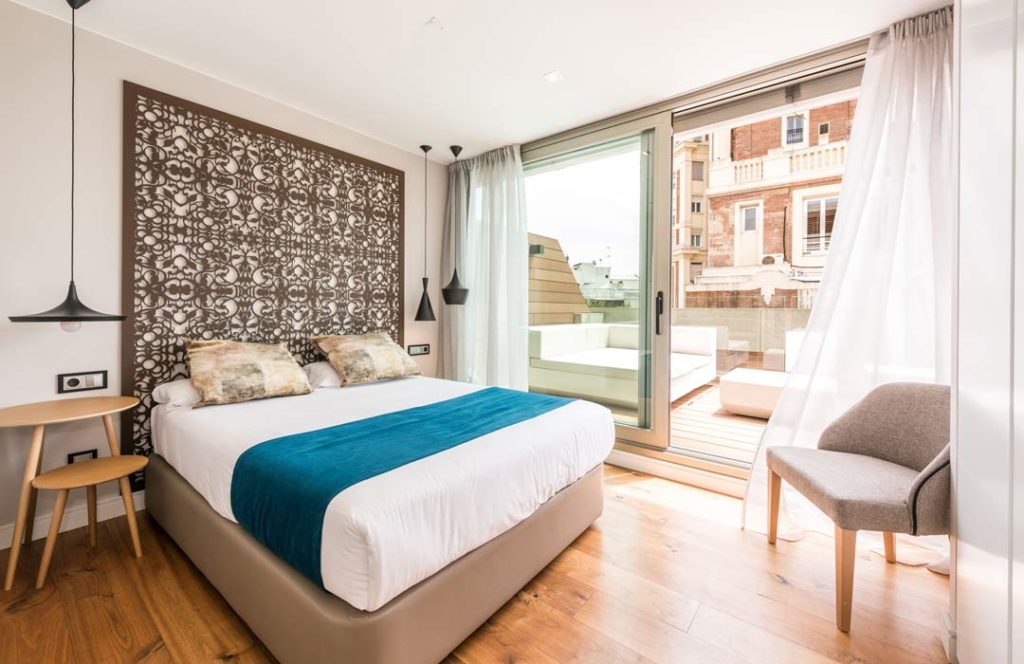
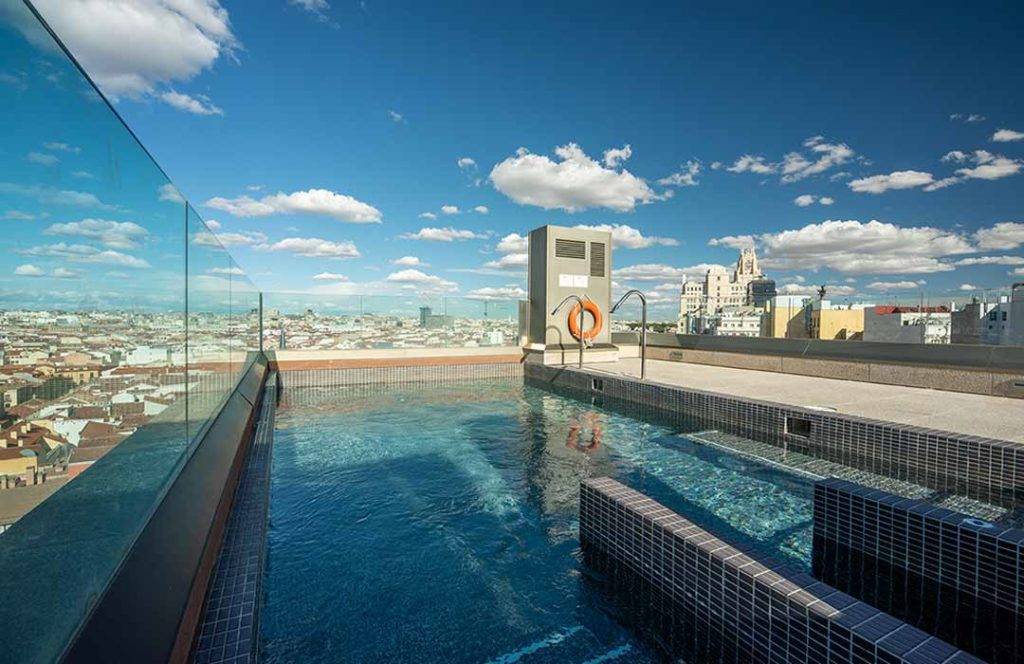
To disconnect. To recover energy and continue the journey. To savor the best of the city in an exclusive enclave. Whatever your stay, the Gran View Apartments in the center of Madrid’s Gran Via have all the amenities you are looking for to enjoy the city without worries.
Prepare your favorite dishes in our fully equipped kitchens, take a break in the living-dining room or cool off in the swimming pool while contemplating one of the most iconic views of the city. Book your vacation rental in Madrid for days, weeks or months and create unforgettable experiences.
-> To book
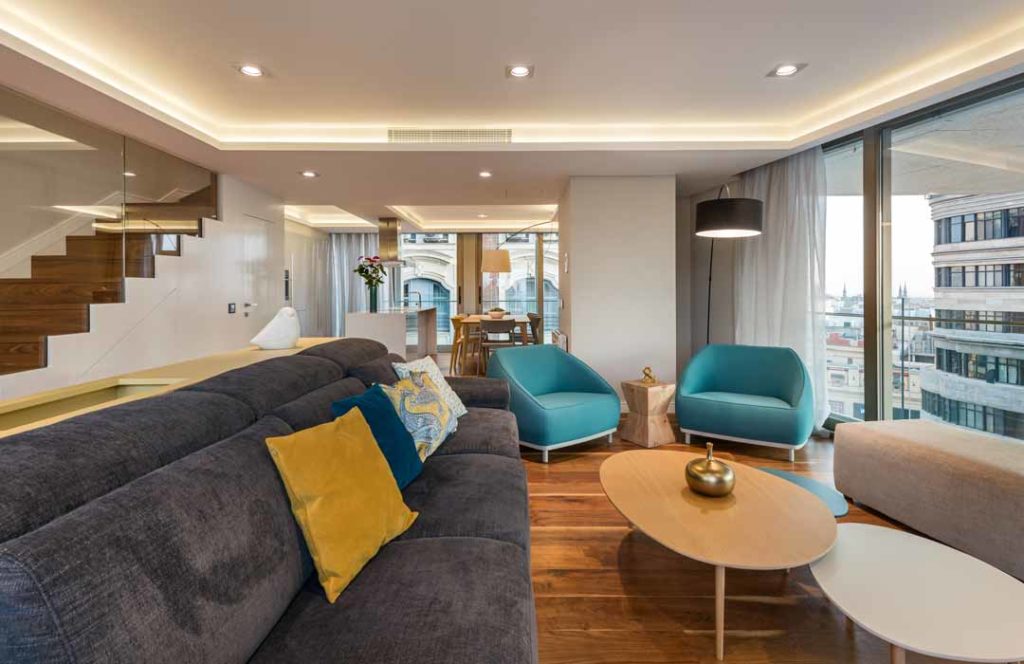
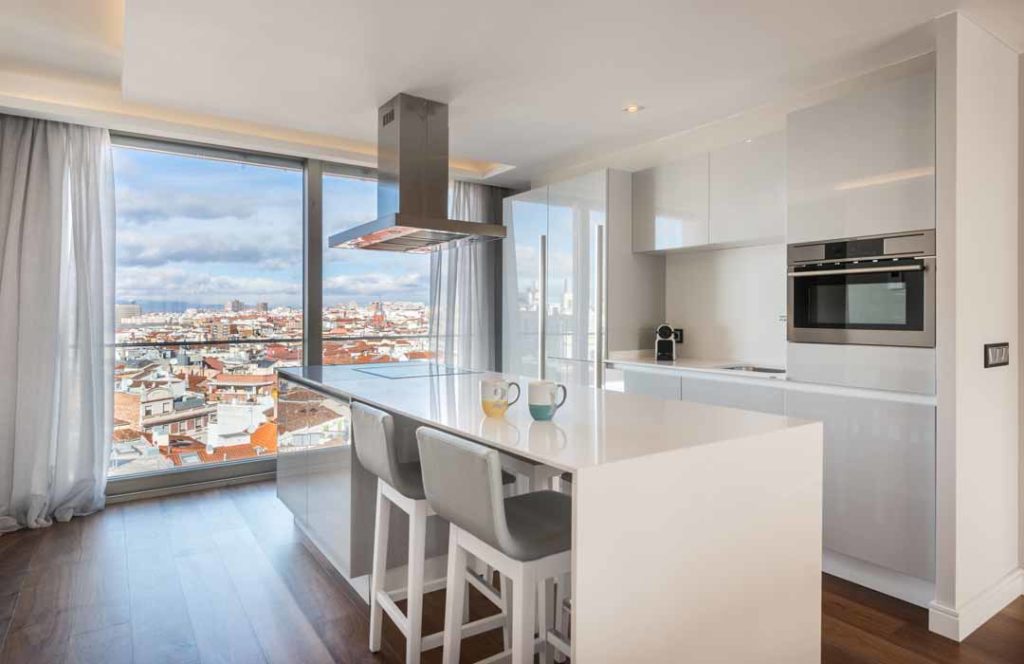

© Pictures gran view apartments
Hotel VP Plaza Espana
Hotel VP Plaza Espana is a 5-star hotel with many facilities such as an on-site restaurant called Botania offering Mediterranean cuisine, as well as a rooftop bar and a buffet breakfast served every morning.
It is one of those luxury hotels where we all dream of sleeping during a stay in Madrid.
There is also a wellness centre and swimming pool, and a car park with a Tesla terminal. The rooms are fully equipped, spacious and luxurious.
RIU Plaza Espana
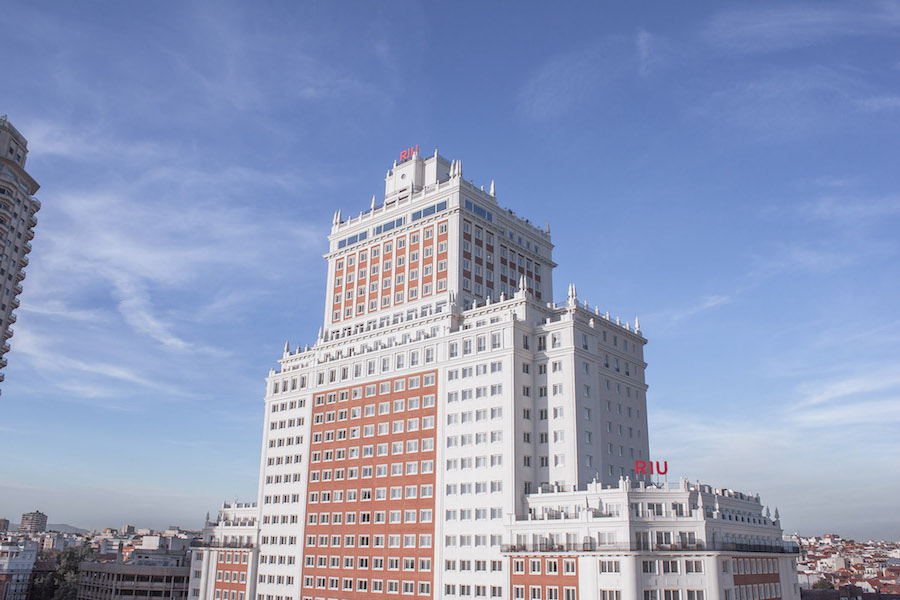
where to stay in Madrid for a weekend / stay in Madrid
This 4-star hotel is located on Madrid’s famous Gran Via avenue, which is home to all kinds of restaurants, shops and bars, giving you the perfect central location for a stay in Madrid.
The hotel has a rooftop with a 360° view and a bar to sip delicious cocktails under the sun, as well as a restaurant, room service, parking, gym and even a disco!
So you will have everything you need to make the most of your stay. The rooms are equipped with air-conditioning, flat-screen TV, are modern and you can also choose family rooms.
If you sleep at the RIU Hotel you will have free access to the hotel’s rooftop, enough to spend a pleasant stay in Madrid.
ME Madrid Reina Victoria
Situated in Plaza Santa Ana, this hotel offers modern and well-decorated rooms, but above all very comfortable! It is one of the most luxurious hotels in the city.
Its location gives you easy access to Madrid’s 3 largest museums: the Prado, Reina Sofia and Thyssen, which are located nearby on Paseo del Arte, forming the Golden Triangle of Art.
Like many luxury hotels, it has fully equipped rooms and a rooftop with an incredible view of the city. If you want to spend a stay in Madrid with all the comforts not far from the museums, this is the place to go.
There is a bar as well as a gourmet restaurant, but also a wellness centre, a car park and pets are allowed!
Hotel Hyatt Centric Gran Via
As its name suggests, the Hyatt Centric Hotel is located on the Gran Via. It has many facilities such as a bar, a restaurant, a café and also a music studio, which is unique in the city!
The rooms are spacious, soundproofed and all have a desk, hairdryer, private bathroom and TV, as well as free internet access.
You can also opt for family rooms, with king size bed, suites and even suites with terrace for a unique experience during your stay in Madrid!
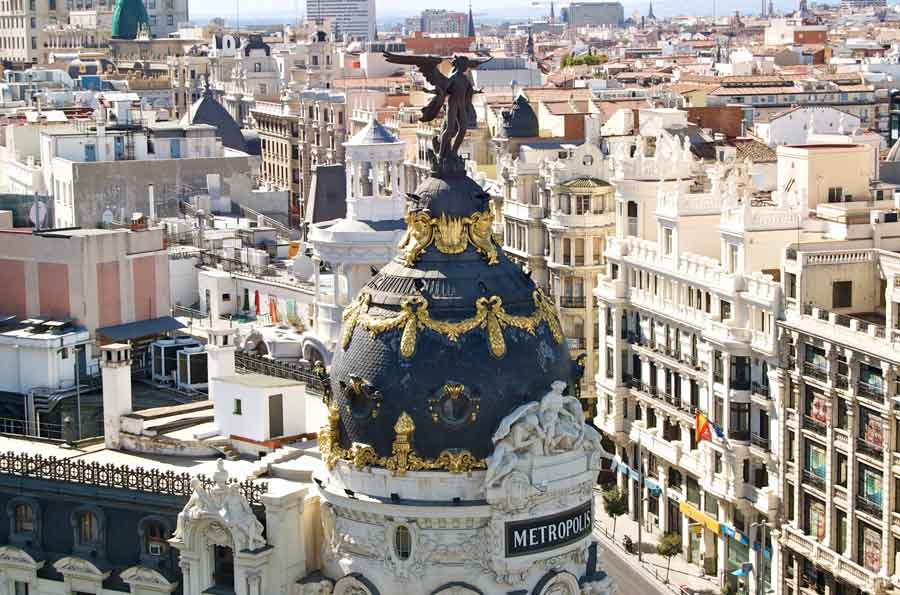
where to stay in Madrid for a weekend / stay in Madrid
Hotel GRAN MELIA PALACIO LOS DUQUES
This hotel is a 5-star hotel in Madrid located near the Royal Palace and has luxurious rooms equipped with flat-screen TVs, good WI-FI connection and services such as a spa, gym, room service and a rooftop with panoramic views of the city.
It also has 3 restaurants on site, a bar and a café. The plus of this hotel are its shuttle services to and from the airport but also the fact that pets are allowed!
Hotel Gran Melia Palacio los Duques is one of the best luxury hotels in Madrid and will make your stay in Madrid unique.
What are the must-see places during a stay in Madrid?
Madrid has many must-see places but here are the 4 places not to be missed during your stay in Madrid.
All focused on the culture and history of the country, they allow you to discover Spain and its riches.
The Prado Museum
The Prado Museum is an emblematic place in Madrid and has an incredible collection of works from the 14th to the 19th century.
It allows us to travel back in time but also to discover works by famous painters such as Velazquez or Goya.
One finds there in particular the paintings “Las Meninas” or “May 2nd“. It is a must during your stay in Madrid.

Prado Museum / stay in Madrid
The Reina Sofia Museum
The Reina Sofia Museum is a museum of contemporary and modern art which exhibits works illustrating both the First and Second World War through its permanent exhibitions, as well as much more current works through temporary exhibitions.
There are paintings by Picasso and in particular the huge painting “Guernica“. It is one of the best museums in Madrid and we recommend you to visit it during your stay in Madrid.

Reina Sofia Museum / stay in Madrid
The Royal Palace
The Royal Palace is no longer the main residence of the royal family, which is why part of it has been reorganized into a museum to help us discover the castle and its sumptuous rooms.
There are many works of art, both paintings and sculptures.
But the palace also houses a huge collection of the royal armoury and instruments, in particular Stradivarius.
Its most beautiful rooms are the throne room and the chapel, and outside, there are two sumptuous formal gardens: the Campo del Moro and the Sabatini Garden.
During your stay in Madrid we advise you to visit it together with the Prado Museum. To spend a unique and authentic moment do not hesitate to book a visit with a private English speaking guide.

stay in Madrid – royal palace of Madrid
The park of the retiro for an afternoon of rest during your stay in Madrid
The Retiro Park is the green lung of the city, once intended to house the king and his court in the Palace del Buen Retiro, which was destroyed, it has now become a public park.
Here you can go for a walk, do sports, have a picnic, sail on the lake or continue to discover the history of the country through the monuments, museums and palaces it houses, such as the Crystal Palace.
If you visit Madrid between March and November it is the ideal place to rest after a visit to the Prado Museum.
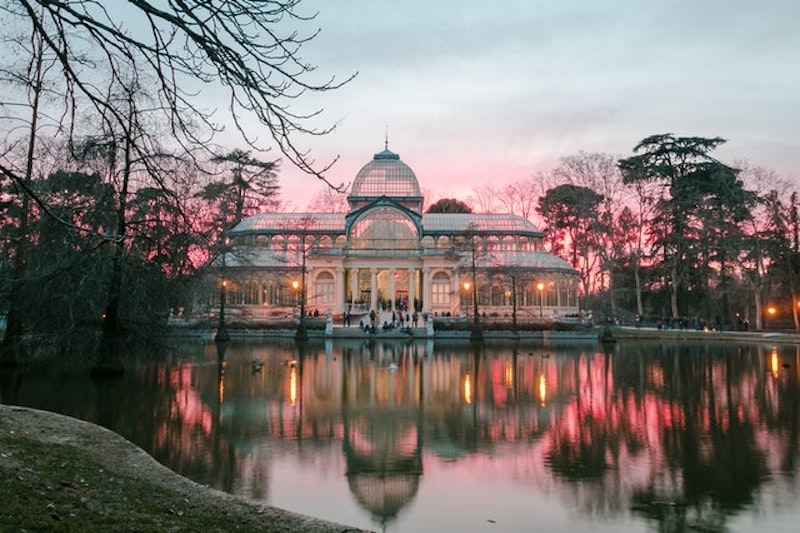
stay in Madrid – Retiro Park
Markets to visit during your stay in Madrid
The two main markets of the city are the markets of San Miguel and San Anton. Both have local and fresh products, but the first one offers tapas dishes and ice creams made by renowned chefs listed in the Michelin guide.
The second one offers take-away dishes, where we introduce you to flavours from all over the world, and also a restaurant with a terrace on the top floor.
If you love gastronomy don’t hesitate to visit our blog, where we have posted articles about Madrid’s markets, restaurants and tapas bars in the capital.
For a unique stay in Madrid book your tapas tour with a private guide now.
stay in Madrid – private tapas tour in english
How can I attend a football match during your stay in Madrid?
Have you always dreamed of attending a Real Madrid match?
If so, I invite you to visit the Santiago Bernabeu stadium, which houses a museum specially dedicated to the team.
There you can visit the trophy room, the press room and even the changing rooms.
But the most impressive thing is the visit to the high stands. I urge you to find out about the schedule of matches and to focus on small games if you do not have a large budget because the price of tickets is quite high, especially if you want to be well placed!
Nevertheless, whether you come to Madrid especially for a match or for a cultural stay, whether you are an unconditional fan of the club or not, to experience a match day is something that I can only recommend that you pass by this mythical address at least once during your stay in Madrid.
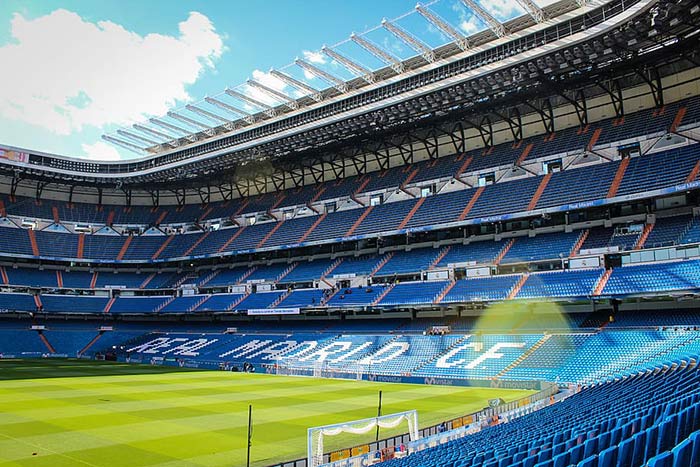
4-day stay in Madrid
Where to eat in Madrid during your stay?
Madrid has many restaurants and tapas bars that you will have the opportunity to discover during your stay.
There’s something for every taste and price, here are a few good addresses for different budgets.
The first restaurant that I recommend you and that is really cheap is “100 Montaditos“. This restaurant chain offers, as its name suggests, a 100ène of variations of small sandwiches with different toppings to add. It’s a unique place to try during your stay in Madrid to accompany a cerveca.
There are traditional Montaditos reminiscent of tapas but also American recipes. There are more than a dozen “100 Montaditos” in Madrid, so there must be one near you!
In order to taste the best tapas, I take you to Casa Labra where you can taste traditional dishes in the restaurant based on Bacalao, Spanish wines of all kinds and succulent tapas.
This century-old tavern in the city is one of the most renowned in terms of typical Madrid cuisine.
The Sobrino de Botin restaurant is known to be the oldest restaurant in the world, and this record is in the Guinness Book of Records. Tourists from all over the world come here to enjoy a traditional and inimitable cuisine with the speciality of suckling pig. It is an address not to be missed and we recommend it to many visitors during their stay in Madrid.
A very popular and trendy place in the city is without a doubt the Salvador Bachiller restaurant. It is located in 3 different places in Madrid: the garden with its terrace, which offers a haven of peace, with its flowers and natural materials, and the café, which offers a very intimate interior atmosphere and also offers very good and original cocktails.
Finally, there is the greenhouse, a restaurant imagined to transport the client to the tropical jungle.
A place not to be missed is the Madrid Ham Museum, quite touristy this address will allow you to buy good quality cold cuts to bring back from your stay in Madrid. There are different addresses, but I highly recommend the Plaza Mayor with its terrace.
There you can taste all kinds of Spanish cold meats but also cheese. The shared trays they serve are perfect for an aperitif on the terrace with friends or family and a good glass of wine!
What are the best bars in the city to go to during a stay in Madrid?
The hat is a hotel with a rooftop with a beautiful view of Madrid and a bar on the top floor.
Here you can meet up with friends in a friendly and relaxing atmosphere, far from the city, around a good beer. If you want to meet new people during your stay in Madrid, this is the rooftop to go to.
The Ojala restaurant located in the Malasana district is a great place to have a drink.
It’s a trendy place and decorated in a relaxed atmosphere reminiscent of the beach and the sea. There are delicious wines and cocktails. The Malasana neighborhood is very well known for its hipster atmosphere and is often part of the to do list of a stay in Madrid. We advise you to visit its vintage shops and trendy bars.
The Café Comercial is an emblematic place in the city and is one of the oldest bars in Madrid.
Well known as a café, it also has a bar and terrace offering all kinds of non-alcoholic drinks, as well as delicious cocktails, beers, wines and vermouth.
What are the typical Spanish dishes and drinks to try during a stay in Madrid?
In terms of drinks, Spain is mainly known for its sangria, although it is very popular with foreign tourists for its fruity and sweet taste; in reality, at least in the capital, this drink is not very common among Spaniards. A good beer is preferred.
Tinto de verano is also very popular among Spaniards, it is a wine but sparkling and very refreshing. The people of Madrid are also very fond of gin and tonic.
In terms of dishes, paella is obviously first on the list, consisting of crispy rice and meat.
Depending on the variant, it can be made with rabbit, chicken or seafood.
Discover now our guide to the best paella in Madrid and don’t fall into the trap of the restaurants that attract tourists during your stay in Madrid.
Next is the Gaspacho, a popular cold soup from Andalusia made with tomatoes, peppers, onions and cucumbers.
Then come the tortillas de patatas, a potato omelette, very easy to make and very popular in the country. If you want to taste one of the best tortilla in Madrid then we advise you to take a look at one of our latest articles, it will help you choose the best restaurant to enjoy a real tortilla during your stay in Madrid.
Finally, there are the tapas. There are different kinds of tapas, which are small dishes served with a drink such as croquetas or garlic shrimp.
The croquetas in this case are traditionally made with ham or chicken that is mixed with béchamel sauce.
They are formed into small balls that are covered with breadcrumbs and fried.
Partying during your stay, Madrid nighlife
Teatro Kapital
Teatro Kapital is one of the best clubs in Madrid. There are people of all nationalities who come here to have fun and a good time.
There are different atmospheres on each of its floors, the club has 7 of them.
For example, on the 2nd floor there are karaoke rooms, on the 4th floor there is a bar and on the 5th floor there is a dance floor where you can dance the night away to Latin rhythms.
Teatro barcelo
Another very good nightclub is Teatro Barcelo. Initially designed to be a cinema and theatre, this place very quickly became an emblematic place in the city to go out at night.
Many celebrities used to come here to dance like the Rolling Stones or Prince.
Formerly a very private club and popular with celebrities, it has now opened up to a new, more accessible and younger clientele.
The 3-storey establishment offers a variety of music from the greatest DJs such as Martin Solveig or Lost Frequencies.
Discothèque Gotham
This club is very popular with students since it is located not far from the university city of Moncloa.
The evenings there are crazy and unforgettable, with young people of all nationalities coming to have fun and meet people.
The club offers a rather house and reggeaton music and closes at 6am, which leaves you the whole night to enjoy, if you close it, you will surely see the first rays of sunshine when you go out.
Where can one attend a flamenco show?
There are various tablao in Madrid to attend typical flamenco shows.
The best known and one of the oldest is the tablao Cardamomo. It’s one of the best flamenco tabaloes in Madrid.
We advise you to visit it during your stay in Madrid, the quality of the show is there.
Every evening from 6pm, there is a show that lasts about 2 hours of flamenco and where dancers, musicians and singers get together and improvise, letting their desires and emotions speak for themselves.
This place also has a bar and restaurant, which allows you to enjoy a good meal while contemplating the show.

4-day stay in Madrid – flamenco in Madrid
What are the events and religious festivals not to be missed during a stay in Madrid?
One of the most popular and unique festivals in Madrid is the festival of San Isidro, patron saint of the city. It’s a holiday in the capital, which is celebrated around May 15.
The people of Madrid dress up for the occasion in traditional dress and parade through the streets of the city.
La Paloma festival is also unique in Madrid as she is the patron saint of the neighborhood called La Latina. It is celebrated around the 15th of August and a procession is held for the occasion.
Visit Madrid at Christmas
When Christmas comes, Madrid lights up in all its colours and brings out its most beautiful decorations.
There are also a number of illuminated cribs in the city and in the Plaza Mayor. Huge illuminated Christmas trees also decorate different squares in the city.
The Plaza Mayor is also the venue for the Christmas market, with numerous food stalls, craft decorations with light decorations for your garden, snowballs or decorations for your own tree.
Christmas is also the time when ice rinks invade the city, where you can admire exhibitions of nativity scenes in the Town Hall or board the Naviluz bus to take a tour of Madrid and its most beautiful decorations.
But one of the most emblematic events is the lottery or Sorteo Extraordinario de Navidad.
You have to buy a lottery ticket and the draw is held at the Teatro Real in the city.
The best places to shop in the city
One of the most popular places to shop in Madrid is of course on the Gran Via, where you will find a wide range of shops of all kinds with ready-to-wear boutiques such as Zara or H&M.
Right next to the Gran Via is the narrower Calle Fuencarral, which is also full of trendy or vintage shops, there is something for every style.
The Malasana district also offers a wide choice of boutiques but with a more vintage style and small independent shops.
The Salamanca district has many luxury shops, more precisely in Calle Serrano with the boutiques of great designers such as Christian Dior or Louis Vuitton.
What to bring back during your stay in Madrid
Your stay is coming to an end and you would like to bring a little piece of Spain with you?
Or you would simply like to bring back a few souvenirs to share this experience with your family and friends?
I can recommend some gifts and souvenirs that are sure to please.
A beautiful postcard of the city always pleases, it is not at all old-fashioned and very authentic.
The museum shops offer wonderful souvenirs, if a friend of yours is an art lover why not offer him a figurine, a photo or a keychain referring to famous paintings such as Las Meninas de Velázquez?
If you are a food lover, why not take a good bottle of Spanish wine or even a Spanish ham with you?
And finally, if you’re a football lover, why not treat yourself to a t-shirt, a ball or a scarf in the club’s official shop! You can also find some articles about Atletico Madrid.
Take advantage of your stay in Madrid to visit Toledo and Segovia
The surroundings of Madrid are also very rich and perfect for a day trip.
The city of Toledo can be reached by train from Atocha Central Station.
The one-way ticket starts at 8€ (9 US$)and the journey takes about 1.5 hours. The city’s Alcázar and its museums are its main attractions. The Alcázars are fortresses with sometimes fortified walls, where the king or prince once resided.
Then comes Segovia, always accessible by train, from 6€ (6,74 US$) and for a journey time of 45 min. There is a magnificent Roman aqueduct, as well as the Alcázar and the museum of Antonio Machado, the famous 19th century poet.
Aranjuez is a charming little town located 35 minutes from Madrid, the outward journey costs around 5€ (5,61 US$) and its most beautiful monuments are the Royal Palace and the Casa del Labrador, another of the town’s palaces built in a neoclassical style.
El Escorial is located 40 minutes from Madrid and is a large city wall which includes a library, a church, a palace and also a necropolis with the pantheon of the kings of Spain.
Finally, Avila is the farthest destination from the capital since it is located 1 hour and 40 minutes by train. It is an ancient medieval city where you can still admire the ramparts that surround it.

Latina neighborhood
The latina neighborhood is one of the best aera in the capital and offers a multitude of things to do and see. What to do in Madrid’s Latina neighborhood ?
- Visit the historic area
- Visit Royal Basilica of San Francisco el Grande
- Eating tapas
- Visit the Rastro Market
- See the Segovia Viaduct
- Visit the Cebada market
- Eating at the Sobrino de Botin
- Shopping
When the sunny days come, the people of Madrid usually go out in the Latina neighborhood to make the most of the good weather.
If you’re planning to visit Madrid you’ll enjoy relaxing over a drink in this bohemian and historic part of the city.
If you are going to go on vacation in Madrid and if you are wondering what to do in Madrid then this article is for you.
In the following paragraphs you will find the top 10 things to do and see in the Latina neighborhood.
If you liked the article do not hesitate to tell us on social networks. If you wish to have our best addresses follow us on our Instagram (@madrid.discovery) we post very regularly the last addresses we discover.
Table of Contents
The historic area of the Latina neighborhood
One of the first things to do when coming to Madrid is to visit the historic centre of the city on the edge of the Latina district.
You will find an article entirely dedicated to this in our blog where we detail in detail the monuments to see and things to do in the historic centre of the city.
On the border of Latina neighborhood you will find part of the historic centre of the city, which will allow you to visit the most important part of Madrid while enjoying the atmosphere of the Latina aera.
The main monuments located in the historic centre of Madrid near the Latina quarter are the following:
The Madrid Opera House, a magnificent building that can be visited, the rear part of the opera house has a large terrace overlooking the Plaza de l’Oriente and the Royal Palace.
A unique point of view that will ensure you one of the most beautiful pictures of your stay.
The Royal Palace of Madrid can be visited all year round. For more information about visiting the Royal Palace do not hesitate to contact us directly.
The Almudena Cathedral, located in front of the Royal Palace of Madrid. Open all year round we recommend you to visit it.
Once the area of the royal palace is visited our itinerary will take you directly to the heart of the Latina district with two of the most beautiful churches of the Latina.

Latina neighborhood – things to do in Madrid
Visit the churches of the Latina neighborhood
In the Latina district you will find two important monuments in the history of Madrid; the Basilica of San Francisco El Grande and the Church of San Andrés.
These two holy places are not very well known by the big tourist groups, which will give you the opportunity to visit them without waiting and in a calm atmosphere.
Opposite the church of San Andrés is the museum of San Isidro, the patron saint of Madrid.
This museum traces the life of Madrid in the time of San Isidro. It is interesting to note that there is a second museum on the history of Madrid, this one is located in the Malasaña district, it tells the modern history of the city of Madrid during the Napoleonic era. This is the Museum of History of Madrid.
San Francisco Basilica
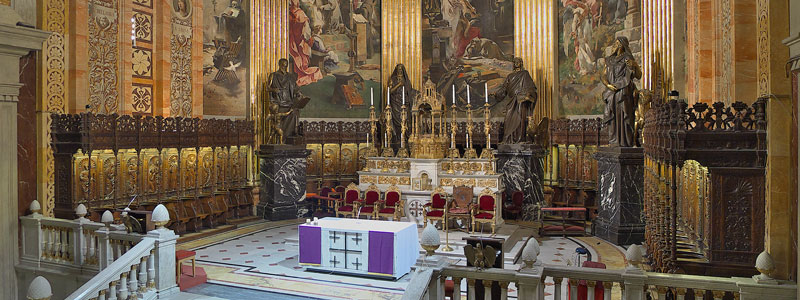
Latina neighborhood – things to visit Madrid
Continuing your visit to the Royal Palace of Madrid and the Almudena Cathedral, you can discover this magnificent 18th century basilica which is located in the Latina neighborhood, once you have crossed the Segovia viaduct it will be on your right.
The Basilica of San Francisco in neo-classical style has the largest dome in Spain and the fourth largest in Europe.
The main attraction of this basilica is the huge frescoes by Goya and Zurbarán.
Calle San Buenaventura, 1, 28005 Madrid, Spain.
The basilica is located not far from the royal palace. All you have to do is cross the Segovia Viaduct.
Opening hours: Tuesday to Friday from 10:30 to 12:30 and from 16 to 18:00. Saturday from 10.30 to 12.30 and from 16 to 18 hours (if no religious act is official).
July, August and September: Tuesday to Sunday from 10:30 to 12:30 and from 17 to 19 hours.
San Andrés Church
Peaceful church in the center of the Latina neighborhood you will be pleasantly surprised during his visit.
Take advantage of your afternoon at La Latina to visit it after having tasted good tapas cava Baja.
Built in the 1600s (the oldest church in the city of Madrid) this church will transport you back in time.
With its magnificent dome, stained glass windows and gold leaf, its decoration will not leave you indifferent.
Once the visit is over (20 min) enjoy a coffee in the San Andres square.
Address: Plaza de San Andres, 1, 28005 Madrid, Spain
Telephone: +34 913 65 48 71
The museum of san isidro in the Latina neighborhood
In front of the cathedral you will find the San Isidro Museum, the patron saint of Madrid.
The San Isidro Museum will take you on a journey through the history of Madrid, from prehistory to the establishment of the court.
The museum’s permanent exhibition displays a total of 153 pieces.
Eating tapas cava baja
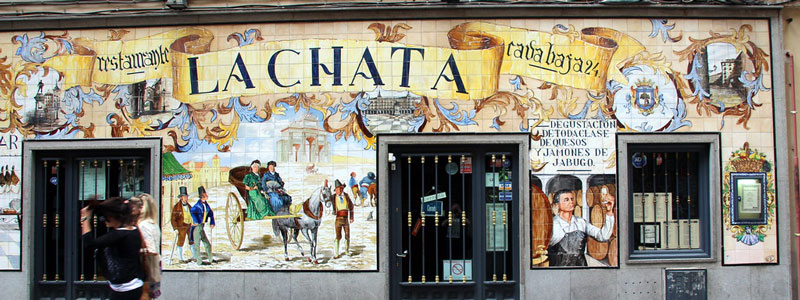
Latina neighborhood- cava baja Madrid
If you visit Madrid you must absolutely taste the Spanish tapas!
You will find a multitude of tapas bars in the city. If you would like to spend your day in the Latina neighborhood or just enjoy some tapas then we recommend the cava Baja.
In this street you will find tapas bars offering authentic and high quality cuisine. Suitable for every budget you will find the restaurant that suits you best in this famous street of Madrid.
Our tapas bar suggestions:
Casa Lucas (very popular wine bar in Madrid)
Taberna Txakolina (to eat Basque tapas)
Going to the rastro market in the latina neighborhood
The Rastro market, located in the district of La Latina is THE market where you can go shopping at the weekend. Much appreciated by Madrid’s inhabitants and tourists from all over the world, this market will bring out the negotiator in you!

Latina neighborhood- EL Rastro
Sunday shopping in the Latina neighborhood

Latina neighborhood- EL Rastro
The Rastro market is open at weekends and on public holidays, but it is mainly on Sundays that the best deals are made.
You will find different areas, a main street with new products, an area of antique shop more interesting for hunting, an area full of sellers of frames and paintings, an area where you will find some thrift shops and finally a more classic area like a garage sale, antique shop.
We advise you to come at 9:30 am / 10:00 am to take advantage of the best offers.
The market is quickly crowded around 12.00 am and it is more difficult to make good deals.
You will also find shops that sell fripe open during the week in the Latina neighborhood, cheaper and less touristic than the Malasana district, we advise you to go there during the week when the district is quiet.
Eating churros in the latina neighborhood
Eating churros in Madrid is an absolute must.
You have different very famous restaurants that offer very good churros like St Gines or Valor located in the historic center of the city.
A very little known address for tourists and adored by the locals is the Rastro, it is the Churrería Santa Ana opened in 1895, Calle de Santa Ana, 7, 28005 Madrid, Spain.
Here you can enjoy the best churros in the city and the hot chocolate will be of great use especially in winter. Churros and chocolate are sold for take away and can be eaten on the street.
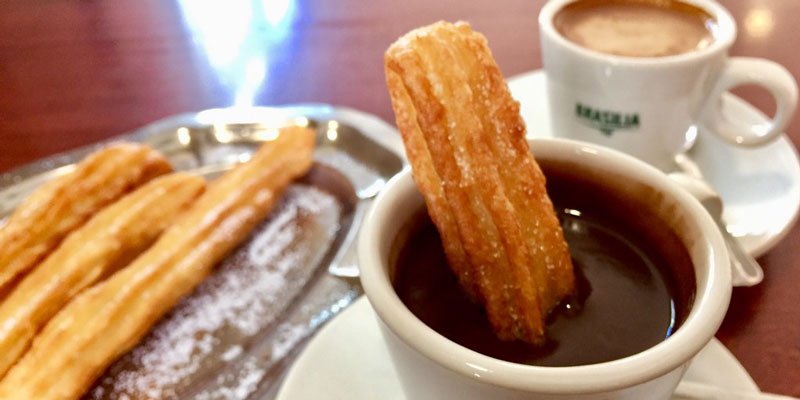
Latina neighborhood – what to do in Madrid – churros
See the Segovia Viaduct
One of the most interesting architectural elements in the Latina neighborhood is the Segovia viaduct.
This viaduct is full of history and connects the area of the royal palace with the latina neighborhood. Take advantage of the visit to the royal palace to see this magnificent construction.
The Segovia Viaduct is famous for its architecture but also for its appearance in various films by director Pedro Almodovar.
We advise you to take from Segovia street, the sunset is magnificent.
Take a mercado tour of Cebada
Built in 1875 the structure of this market is based on the Halles de Paris. The mercado de la cebada close to the Rastro market is one of the central points of the city and many people from Madrid come to shop in this market.
There you will find fresh products from all over Spain, ideal for bringing back good products. You can also find tapas bars in the surrounding area.
You will find this market near the subway “La latina“.
Plaza de la Cebada, 15, Madrid, Spain
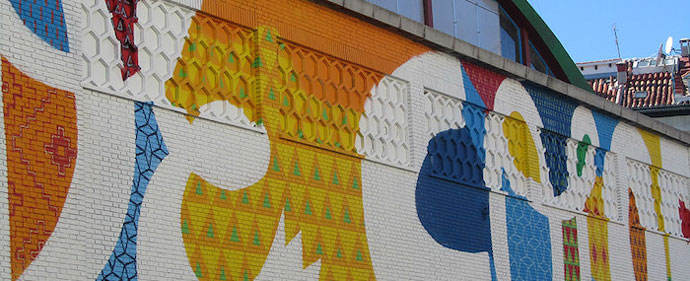
Latina neighborhood
See the Toledo Gate in the latina neighborhood
Madrid being in the past protected by a great wall forming a citadel, there are still many vestiges of this wall and in particular large arches.
Almost every quarter of the historic centre of Madrid has its gate. The latina neighborhood has the Toledo Gate (almost 20 metres high and made up of 3 arches) currently used as a roundabout, a true vestige of Madrid’s history.
We recommend you take a tour to see the size of this gate.
Eating in the oldest restaurant in the world
One of the most famous attractions at foodies is the restaurant Sobrino de Botin. It is the oldest restaurant in the world, you will discover a unique place with a low ceiling on 4 floors in the basement.
Very popular with tourists and gourmets, we advise you to book via their website to avoid queues and wait almost 40 minutes to eat.
An authentic place that we recommend to lovers of gastronomy and unique places.
Calle de Cuchilleros, 17, 28005 Madrid

Latina neighborhood
Shopping
Latina neighborhood is not very well known for shopping, but the narrow streets of the Rastro offer some nice surprises and you will find many shops where you can buy frippies at up to half the price of those in the Malasana district.
Going out for a drink in the latina neighborhood
The latina neighborhood is famous for its evenings, you will find a different atmosphere from the district of malasana.
Less hipster, you will not find a club as trendy as in malasana but small bars that close late.
If you like the bohemian atmosphere and rudimentary bars then this area is for you.
You will find your happiness near the tirso de molina metro station, a real meeting place for Madrid’s locals. The Cebada market area is also a very good place to find bars and enjoy an evening with friends.
(BONUS) Or eat in the Latina neighborhood?
If you plan to eat in a restaurant or tapas bar when you visit the latina neighborhood you will be lost in front of the huge range of restaurants on offer.
How do you know if the establishment is too touristy? Are the dishes of quality? Or do the people of Madrid eat in this neighbourhood?
We know the time when it’s time to eat and we have no idea where to eat.
To make it easier for you to prepare your stay we have made a selection of 4 good restaurant addresses and 4 good tapas bars for a successful meal or dinner.
If you would like to have a complete list of the restaurants in the city by district please visit our blog, where you will find the ultimate guide to the city’s restaurants.
TOP 4 List of good restaurant addresses in the latina neighborhood.
Discover our top 4 restaurants in Madrid’s latina neighborhood:
Astor: Mediterranean cuisine
Calle del Almendro 9 local B, 28005 Madrid Spain
Phone: +34 910 39 80 00
Cervecería La Mayor: Spanish Cuisine
Calle Mayor nº 77, 28005 Madrid Spain
Phone: +34 911 30 24 35
Casa Lucas: Mediterranean cuisine & wines
Calle Cava Baja 30, 28005 Madrid Spain
Phone: +34 913 65 08 04
Pajaritos Mojados: Gastronomic cuisine
Calle Humilladero 3 Detras Del Mercado de la Cebada, 28005 Madrid Spain
Phone: +34 912 21 88 89
TOP 4 List of the best tapas bars
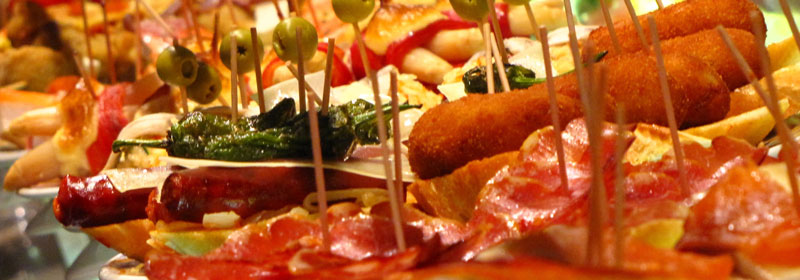
la Latina Tapas in latina neighborhood
TOP 4 List of the best tapas bars
Discover our top 4 tapas bars in Madrid’s latina neighborhood:
Taberna la Concha : Tapas bar / tavern
Calle Cava Baja 7, 28005 Madrid Spain
Phone: +34 616 91 06 71
Taberna Almeria: Tapas bar / tavern
Calle Aguas 9, 28005 Madrid Spain
Phone: +34 913 64 15 71
La Perejila: Tapas Bar
Calle Cava Baja 25, 28005 Madrid Spain
Phone: +34 913 64 28 55
AlliOli Valencian Food: Valencian cuisine
Calle de Carlos Arniches 14, 28005 Madrid Spain
Phone: +34 646 41 46 29
If you come across this article while preparing for your stay in Madrid and you have the following questions:
What to visit in Madrid? What to visit in Madrid in 2 days? What are the best museums in Madrid? Where to eat in Madrid? What to do in the Latina district?
Then take a tour on our blog to find out what you’re looking for.
If you don’t have the answer then don’t hesitate to write to us, here is our email: info@madrid-discovery.com
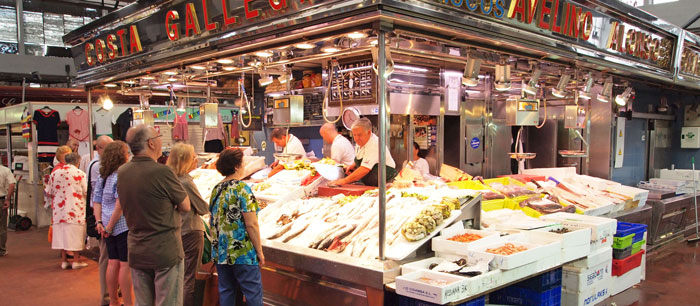

Swimming pools Madrid – Lifestyle & Relaxation
The ultimate guide to Madrid’s swimming pools is ready! The Madrid Discovery team has toured Madrid’s municipal swimming pools and the best hotels in the city centre to advise you on the best swimming pools in Madrid. You will have the choice between large municipal pools, Olympic pools, hotel pools, rooftop pools and amusement park pools.
Discover now the best addresses in the city, whether on a rooftop, in an Olympic swimming pool or in an amusement park.
To complete this article you will find at the end of our post a list of useful resources to plan your afternoon at one of Madrid’s swimming pools.
If you liked this article do not hesitate to share it around you and tell us about it on our social networks, it will be a pleasure for the whole Madrid Discovery team to answer it.
Find us on Instagram and Facebook to get the latest news from Madrid Discovery.
Table of Contents
Madrid’s municipal swimming pools
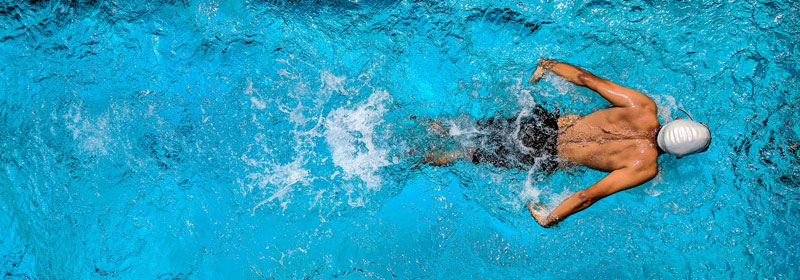
Swimming pools Madrid – Madrid public swimming pool
Madrid is one of the Spanish cities with the most public swimming pools in its city centre.
Whether you want to do laps, get ready for the Olympics or just go sunbathing you will find your ideal pool in this guide.
We’ve listed Madrid’s municipal pools, Madrid’s elevated pools and water parks.
For more information about schedules we advise you to call the pool in question or visit their website (in our resources).
Important information : Madrid’s swimming pools are open from May 5th to September 20th (information 2020 – covid-19 – schedules will probably be affected, please contact the pools directly before going there).
Rates for pool admission: Adult (4,50€) / Youth (3,60€)*.
*2019 tariff likely to change in 2020.
Swimming pools in Madrid: The polideportivo Canal de Isabel II
It is in the Chamberí district in the heart of Madrid’s city centre that you will find this very complete sports complex for all tastes.
In addition to a large outdoor swimming pool, the centre offers tennis courts, a paddle court, a fronton, a gym and a sports hall.
To enjoy the sun and the beautiful days a beach area and a solarium are accessible.
Here you will find one of Madrid’s swimming pools with the best public transport connections.

Swimming pools Madrid – Tennis
Address: Avenida de Filipinas, 54 28003
Opening hours of the sports complex: 08.00 to 22.00 hrs.
Swimming pool opening hours: from 11:00 am to 8:00 pm (In 2019, it was open from June 1st to September 8th)
Editor’s note: Very pleasant swimming pool located in the very centre of Madrid, a few steps away from the metro. Ideal to spend a relaxing afternoon and escape the stress of the city. A favorite for the facilities of the sports complex.
Madrid Swimming Pools: Lago de Casa de Campo
Located next to Casa de Campo and the Madrid Rio district, this is one of Madrid’s most famous swimming pools and one of the most popular in the city in the summer.
With these two pools it can accommodate many families and you will find two large pools, one of 36 m and a second of 33 m (currently under construction).
Address: Paseo Puerta del Ángel, 7 28011
Opening hours: (Winter time) Monday to Friday: 08:30-21:00. This is one of the largest winter swimming pools in Madrid.
Swimming pool closed at weekends.
Summer timetable: Monday to Sunday, 11:00 am to 8:30 pm.
Editor’s note: Very pleasant and family pool located in an outlying area of Madrid’s historic city centre: Puerta del Angel / Casa de Campo.
Ideal for spending an afternoon with the family, especially to enjoy the Casa de Campo and its multitude of activities. You will find more pools in Madrid’s more central location in the rest of the post.
Centro deportivo municipal Vicente del Bosque
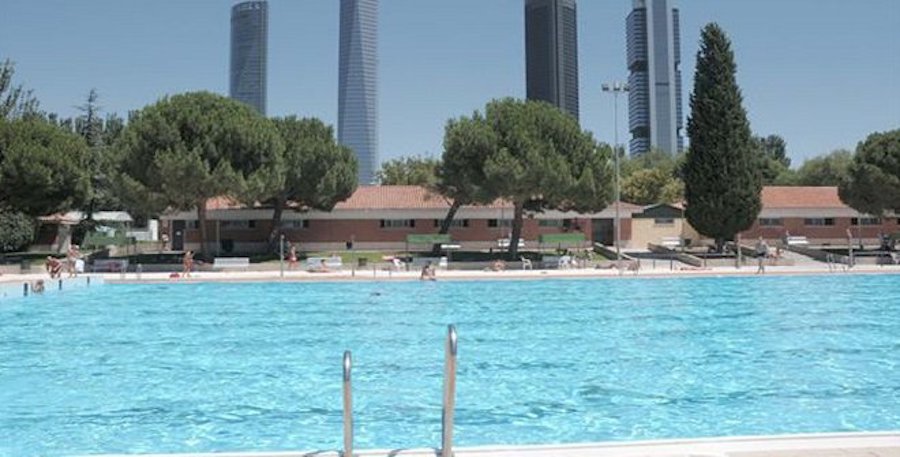
Swimming pools Madrid – centro deportivo municipal Vicente del Bosque
It is close to the business centre of Madrid and its famous 4 towers that the del Bosque sports centre is located.
It is one of the largest swimming pools in Madrid and its city centre. With a winter pool and two summer pools of 50 m each you can swim in complete tranquility.
There is also a children’s pool and many activities.
The sports centre has fields for volleyball, beach volleyball, tennis, skating, hockey, indoor football, football, handball, basketball and badminton.
Address: Avenida Monforte de Lemos, 13 28029
Opening hours: Monday to Sunday and on public holidays from 8:30 am to 8:30 pm.
Outdoor swimming pool: 11:00 am to 9:00 pm
Editor’s note: Very large swimming pool close to the business centre, if you finish work at 3pm in the summer like many Spaniards do not hesitate to take a walk there to relax.
One of Madrid’s swimming pools closest to the business centre, ideal after work.
Swimming pool of the Universidad Complutense de Madrid
In a natural and quiet environment you will find the swimming pool of the Complutense University of Madrid.
Close to the university rectorate and surrounded by residences and museums, it is an ideal place to enjoy a summer afternoon in a quiet atmosphere.
Open only in the summer and provided you are a student or accompanying a student you will be able to enter.
Address: Calle del Obispo Trejo, 8 28040
Opening hours: In 2019: 1 Jun – 8 Sep: Mon – Dom 11:00 – 20:00 hrs.
Editor’s note: Swimming pool very little known to Madrid’s inhabitants because it is in the centre of the university.
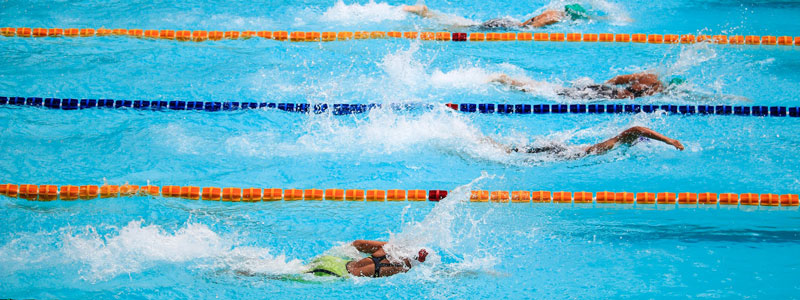
Swimming Pools Madrid – Madrid Public Swimming Pools
Puerta de Hierro sports park swimming pools
The Puerta de Hierro Sports Centre is located on the Pardo road near the Manzanares River.
Due to its size and the variety of activities available, the Puerta de Hierro is one of the main sports areas in the Community of Madrid and up to six Madrid federations (golf, paddle, ball, canoeing, rugby and archery) currently have their headquarters here.
It is one of the largest swimming pools in Madrid and the largest sports centre in the city.
The Puerta de Hierro Sports Centre has the largest swimming pool in the community of Madrid with an area more than 7 times the size of an Olympic pool (the largest pool in Europe when it opened).
You will find three interconnected pools, one of which is an Olympic pool and a children’s pool.
To complete this you will find a cafeteria, showers / toilets and changing rooms.
A very welcoming complex for all types of activities.
Address: Carretera de la Coruña , km. 7 28035
Hours of operation: Facility hours: 08:00 to 22:00
Swimming pool opening hours: from 11:00 am to 8:00 pm (in 2019, it will be open from June 1st to September 8th)
Editor’s note: Swimming pool very far from the centre of Madrid. Ideal if you live on the outskirts of Madrid or if you want a bit more peace and quiet.
Madrid swimming pools & roof top
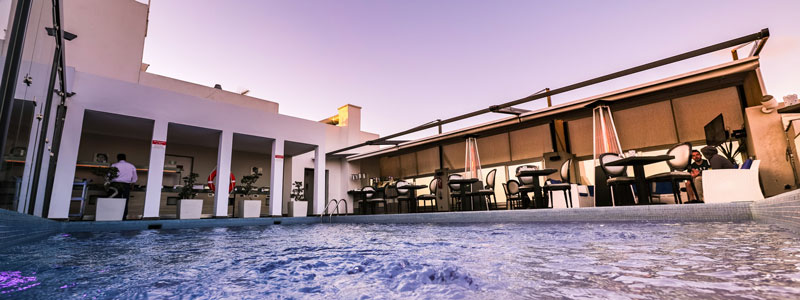
Swimming pools Madrid – swimming pools Madrid hotel
If you prefer to relax in the pool of a trendy rooftop with a cocktail then we have just the thing for you!
Ideal for an afternoon of cultural visits or after a meeting in the city centre, rooftops offer a good alternative to Madrid’s municipal swimming pools.
“Discover our guide to the best rooftops in Madrid and become a specialist in Madrid’s best deals.
Are you planning your stay in Madrid? Don’t hesitate to contact us to answer all your questions about Madrid’s swimming pools, sightseeing or hotels!
Dear hotel – Rooftop piscine
Located at the foot of Plaza de Espana you will find the discreet Dear hotel.
Once on the rooftop you will discover a terrace overlooking both Gran Via and the Malasaña district, you can also explore the towers of the business centre.
You will find a bar and restaurant as well as a swimming pool, all in a cosy atmosphere.
Enjoy a relaxing moment with a cocktail and stunning views of Madrid.
Address: C/ Gran Vía, 80, 28013 Madrid
Editor’s note: Very small pool (no more than 5 people). It is one of the pools in Madrid with a view of the 4 towers of the business center.
Hotel indigo – Exclusive swimming pool
Situated on the Gran Via, this exclusive hotel is ideal for a stay in the capital.
You will find an infinity swimming pool and stunning views of Madrid. The hotel is located on the Gran Via and has a swimming pool.
The indigo hotel is a 5-star hotel of high standing.
Their terrace is open only part of the year on sunny days. It is closed in winter due to the temperature.
Address: Calle de Silva, 6, 28013 Madrid
Editor’s note: Exclusive swimming pool overlooking the Gran Via, an exclusive and select place that will not leave you indifferent. Entrance is free and the staff is very professional. Some of the waiters even speak French.
Rooftop circulo de bella arte

Swimming pools Madrid – pools Madrid rooftop
Emblematic rooftop of the city of Madrid the Circulo de Bella Arte is the best rooftop with pool in Madrid.
Enjoy a 360° view from your deckchair while enjoying delicious cocktails. The pool is not open all year round, please check their website for the pool schedule (depending on the events they organize it is open or not).
-> website of the circulo de bella artes
The rooftop is open almost all year round and has a closed part with heating to spend a warm moment even in winter.
Take advantage of a morning to visit Madrid on a private tour with one of our guides and spend your afternoon at this rooftop while relaxing with a shopping session!
Address: Calle de Alcalá, 42, 28014 Madrid
Editor’s note: Swimming pool with one of the best views of Madrid, very select, you will have to pay 4€ to access it. You will find an international clientele there and we advise you to go there early in the afternoon to find space easily. One of the most international swimming pools in Madrid.
Swimming pools & water park in Madrid
Even better than municipal swimming pools, water parks.
Ideal to enjoy a summer afternoon with the family! Here is a selection of the three main parks in the community of Madrid.
Aquopolis Villanueva de la Cañada
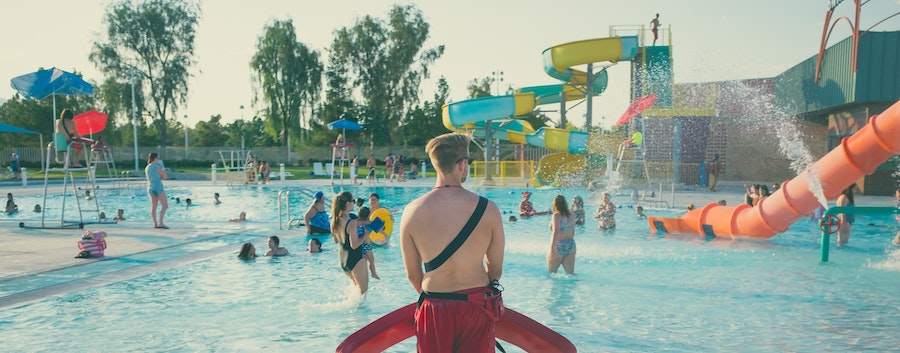
Swimming pools Madrid – aquapolis Madrid
It is in Villanueva de la Canada, 40 minutes from Madrid, that this great amusement park is located.
Very popular with Madrid’s inhabitants, you will find many attractions suitable for all ages. Aquopolis is a theme park with different worlds and different attractions and adrenaline levels.
Discover the Black Hole, a completely closed slide, the Splash, a 15m high waterfall or the Kamikaze.
Address: Av. de la Dehesa, s/n, 28691 Villanueva de la Cañada
Editor’s note: Aquopolis is the favourite water park of Madrid’s inhabitants and tourists from all over the world. A sure bet to spend a sensational afternoon! To be able to enjoy the activities before everyone else come as soon as it opens.
Warner Beach Park
Less than 30 minutes from downtown Madrid discover the famous Warner theme park.
Located 29 km south of Madrid, in the town of San Martin de la Vega.
It is ranked the third largest water park in the country after Port Ventura in Barcelona and Siam park in Tenerife.
Take advantage of the first rays of sunshine to spend an afternoon with your family and have fun at the water attractions at Warner Beach Park.
With almost 10 attractions this park will suit the whole family.
Address: A-4 road, Exit 22, 28330 San Martín de la Vega.
Editor’s note: Water park very close to Madrid, family and very well organized it will be perfect to spend a summer day.

Swimming pools Madrid – warner park Madrid
Madrid amusement park with swimming pool
Located near the Casa de Campo the amusement park in Madrid will offer attractions for young and old.
Take advantage of the water park to relax and enjoy a successful afternoon.
Address: Casa de Campo, s/n 28011 Madrid
Editor’s note: An amusement park located in the very centre of Madrid. Accessible by metro it will be perfect to enjoy an afternoon.
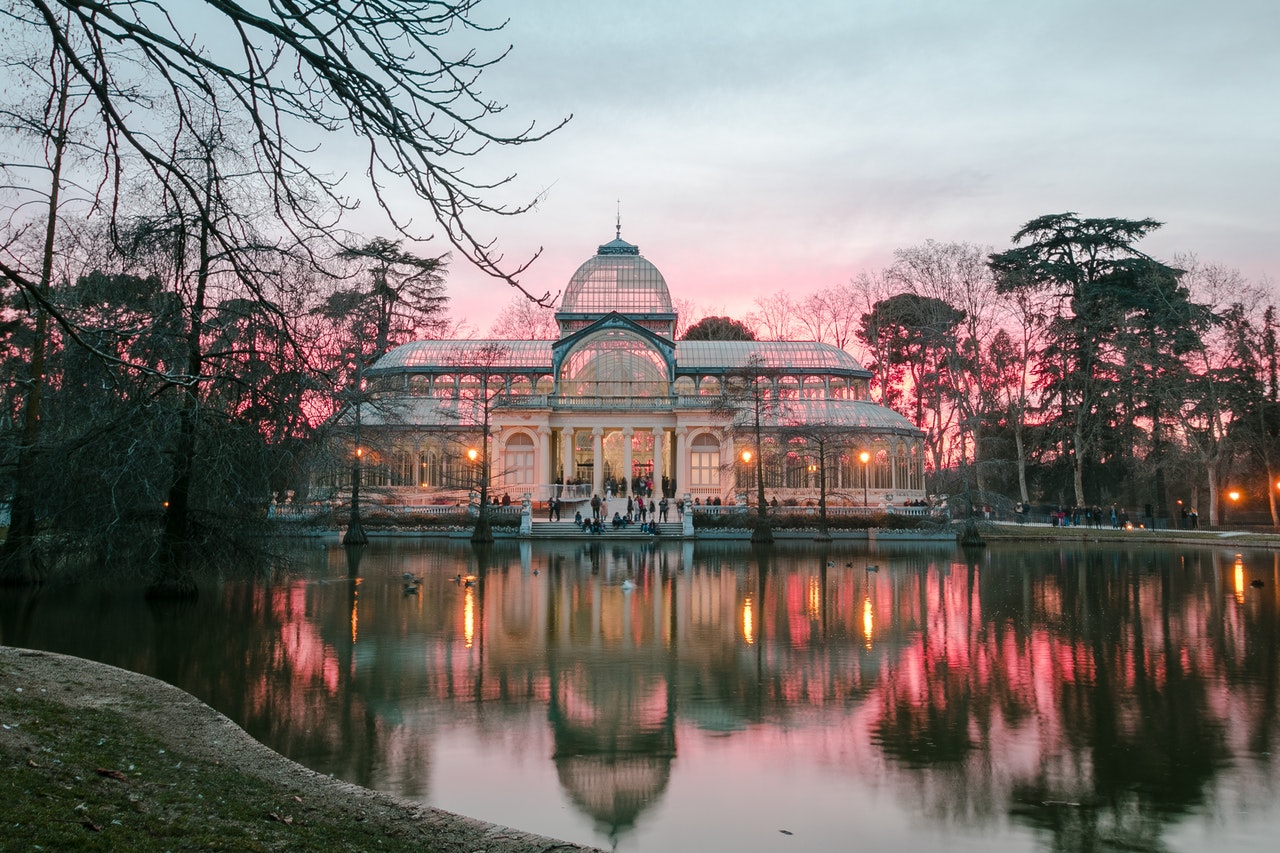
The Retiro Park
This true haven of peace situated in the heart of the city is composed of multiple fountains, gardens, sculptures and even a large lake where you can sail.
It is also known as a cultural place since it hosts many museums such as the great palace of Velázquez and the crystal palace. If you come to visit Madrid it will surely be part of your to do list!
Where is the Retiro Park located? How do I get to the Retiro Park? What to do at the Retiro Park?
Discover in this article all the answers to your questions. If you’re planning to visit Madrid for a weekend or during your future holidays then feel free to check out our blog.
Table of Contents
The history of Retiro Park
Called by the people of Madrid “parque del Retiro” or “parque del buen Retiro“, it was so named because it was once the spiritual retreat of the kings of Spain.
The construction of a second home for the king and his court began there, giving rise to the Palacio del Buen Retiro.
The gardens, formerly places of entertainment and recreation for the royalty, make up the park that we know today. In fact, the palace was destroyed, as it deteriorated over time due to poor quality materials and the Napoleonic attacks from 1808 to 1814. Thus, the majority of the remains of the palace are its gardens.
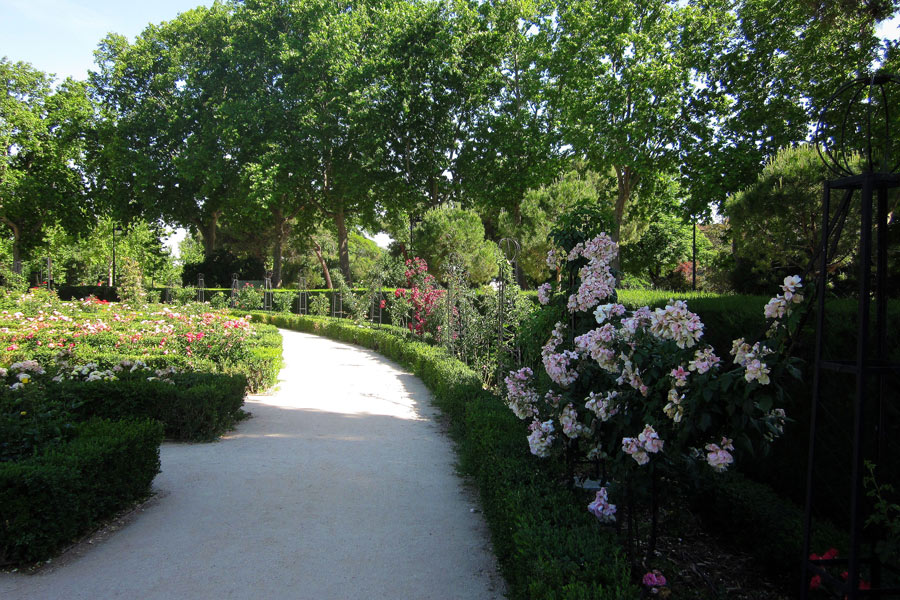
The Retiro Park roses
The park in a few figures
Created between 1630 and 1640, and covering more than 125 hectares, the Retiro Park has more than 15,000 trees, as well as numerous fountains, sculptures and gardens.
Formerly reserved for the king and his court, in 1868 it was opened to the public for good.
Practical information about Retiro Park
The Retiro park is accessible by metro line 2 and also by the following bus lines: 1, 2, 9, 15, 19, 20, 26, 51, 52, 61, 63, 74, 146, 152, C1.
Madrid Metro Tarif: The price of a metro ticket is 1.50€, the same for the bus.
Opening hours of the Retiro Park :
Between April and September: from 6am to midnight.
Between October and March: from 6am to 10pm
Price: free entrance
The main entrance to the Retiro Park is located in the Plaza de la Independencia, next to the Puerta de Alcala, an old gate that provided access to the city, is located.
It is built in a neoclassical style and resembles a triumphal arch. It can be reached by bus line 19 and leads directly to the Statue Walk.
Palaces of the Parque del Buen Retiro
El parque del buen Retiro is home to many buildings remarkable for their architecture. Its two most famous palaces are the Crystal Palace and the great Palace of Velazquez.
They are very different, and both are must-sees in El parque del buen Retiro, whether for a cultural getaway or a simple stroll.
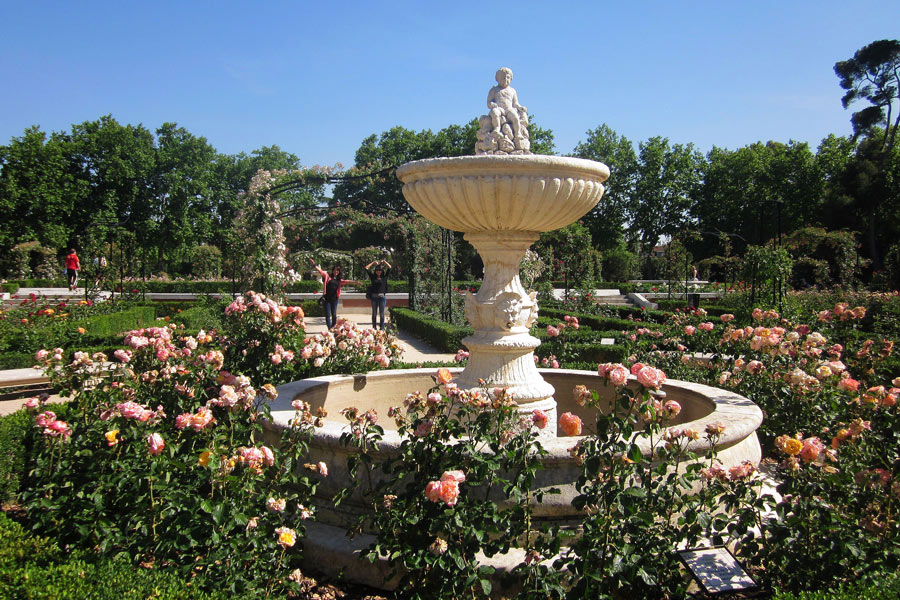
The Retiro Park roses
Palacio de Cristal del parque del buen retiro
The Crystal Palace of the Buen Retiro is the work of the architect Ricardo Velasquez, it was originally built to house an exhibition of the Philippine Islands, hence its original use as a greenhouse.
Indeed, entirely composed of large windows and an iron structure, it is often compared to the palace of the same name located in Hyde Park in London. They both have the same structure and were both originally built to house an exhibition.
Today it regularly hosts exhibitions from the Reina Sofia Museum of contemporary Art. Both an exhibition space and a work of art in itself, it is very popular with tourists as it perfectly captures the light to make superb photos in a unique environment.
With its high structure and dome reaching 22 meters high, the crystal palace overlooks a small lake.
Entrance and access to the exhibitions are free of charge.
Please note, however, that the Crystal Palace does not have the same opening hours as the Retiro Park. Indeed, in high season, from April to September, it opens at 10 am and closes at 10 pm, the rest of the year it closes at 6 pm.
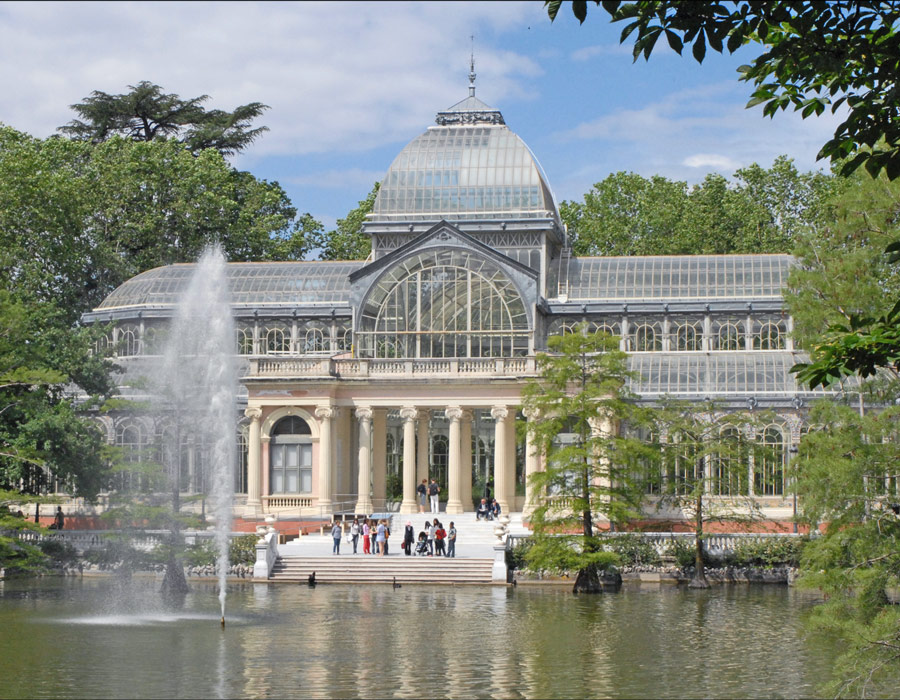
The Retiro Park – Crystal palace
Great palace of Velázquez
The great palace of Velázquez is similar to the Palacio de Cristal since it was built by the same architect, inspired by the same work and initially used for the same purpose.
However, it was built a little earlier between 1881 and 1883 and to house the National Mining Exhibition.
Its structure is also made of glass and iron with a high dome, but it differs for its many brick pillars and its earthenware decoration from the Royal Manufactory of Moncloa. It is also an annex of the Reina Sofia Museum where you will find sculptures and works of modern and contemporary art.
Access is free of charge.
The palace is open from April to September between 10 am and 10 pm, from November to March between 10 am and 6 pm and finally in October between 10 am and 7 pm.
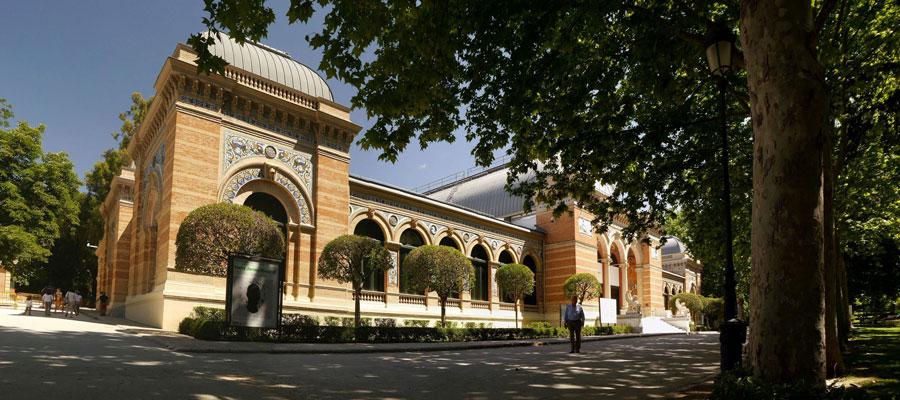
The Retiro Park – Velasquez Museum
The museums of the Retiro Park
The Retiro Park is not only a green expanse, it is also home to numerous museums, former remains of the Palacio del Buen Retiro, the king’s second residence originally built to entertain monarchs.
Today the palace has been destroyed but some remains remain, such as the Salón de los Reyes (Hall of the Kingdoms) or the Cason del Buen Retiro.
Hall of the Kingdoms
Formerly used as a royal reception room but also as a throne room, this room was later transformed into an army museum.
It is also one of the few remains of the Palacio del Buen Retiro. However, in 2010, the museum was transferred to Toledo -the neighbouring city of Madrid- , so the place had to reinvent itself and was renovated to become an exhibition room for the works of the Prado Museum.
Currently, the room is still under renovation but is composed of numerous windows, a large floor area and also a large ceiling area, which will soon be able to accommodate the works that once adorned its walls. Among them are the 5 equestrian portraits of the royal family and the surrender of Breda, all painted by Diego Velazquez.
The opening was originally planned for the Prado Museum’s bicentenary in 2019, but since the renovation has been delayed, its date of reopening is not yet known.
Cason del buen retiro
Former ballroom of the court of Felipe IV, this building is one of the few remains of the Palacio del Buen Retiro.
The building has undergone major renovations to enlarge the hall and restore the fresco that decorates the vaulting by Giordano.
In the past, the hall housed many works from the Prado Museum, including the famous work by Pablo Picasso, Guernica, which was exhibited there before being transferred to the Reina Sofia Museum.
Today, however, the building is dedicated to the Prado Museum Studies Center for research and training of art experts. It also houses various departments dependent on the Prado Museum, such as the museum archives, its documentation and conservation centre and its library.
This building therefore contains many works on paintings, sculptures and drawings from the Middle Ages to the 19th century.
Since the building now houses a training centre and valuable books, it is no longer open to the public but you can still admire its beautiful baroque façade.

The Retiro Park – Crystal palace
The statues and fountains of the Retiro Park
The Retiro Park is full of all kinds of artwork. You can admire beautiful Greek-style statues, as well as imposing and symbolic monuments such as the one erected in honour of King Alfonso XII.
You will also find many fountains, each work has a story and you will discover some of them in the following article.
Visiting Madrid and the Retiro Park with a private guide is a unique experience that will not leave you indifferent. Book your private tour now with us to know the secrets of the city and the park.
Monument Alfonso XII a central piece of Retiro Park
This monument was built in honour of King Alfonso XII, this statue overlooks the pond at 30 metres high and is located near the large lake in the centre of Parque del Retiro.
This former king of Spain is for the country synonymous with peace, he was a humble man at the service of the poor and the sick.
Construction began in 1902 and was inaugurated in 1922 when the statue of the king on his faithful steed completed the monument.
This major work of art in the 70-metre wide park is thus composed of a central statue to which arched columns are added. The columns themselves are adorned with sculptures such as lions guarding the monument, sirens and other works representing various values dear to Spain.
These include Peace, Freedom, Progress, but also the Spanish Army and Navy, Arts, Sciences, Industry and Agriculture.
The entire monument is made of bronze and marble.
The Fountain of the Fallen Angel in the Park del buen Retiro
This fountain overhung by a statue representing an angel who was expelled from Paradise, is the only work on earth where the Devil is represented.
Designed by sculptor Bellver in 1878, it was greatly inspired by John Milton’s poem Paradise Lost. Built for the Universal Exhibition in Paris, it is made of bronze and stone. At the top, the angel with outstretched wings seems to have just landed in hell, frightened, a snake wraps itself around him.
At the base of the fountain, where the water flows, there are demon heads holding lizards and snakes in their hands.
Coincidence or not, it would seem that the statue is located exactly 666 meters above the sea, a figure often associated with the number of the Beast.
You will find this statue on the paseo Fernan Nuñez of the Retiro Park.
The Promenade of the Statues of Retiro Park
Linking the big pond to the Spanish Gate, this main avenue of the Retiro Park will take you on a journey through time. You will find many statues of former kings of Spain all along your walk.
Initially designed to be placed in the Royal Palace during the reign of Fernando VI, they were later removed by order of the new King Carlos III.
They are now spread over three areas of the city: the Sabatini Gardens which make up the gardens of the Royal Palace, the Plaza de l’Oriente located between the Palace and the Royal Theatre and the Retiro Park.
The Retiro Park Pond
Built between 1634 and 1636, one could observe the king and his court enjoying a stroll on the water or water and music shows since a small island was present in its center. Today it has been submerged by water.
A little anecdote: in 1964, the pond was used as a film set for the film “The fabulous world of the circus” which had John Wayne among its famous cast.
This artificial lake allows tourists and locals to rent a solar-powered boat or rowboat to enjoy the sunshine with a short walk on the water. The lake is also dedicated to canoeing and kayaking activities, a real attraction of the Retiro Park. We advise you to come as soon as the lake opens to enjoy an afternoon on the boat.
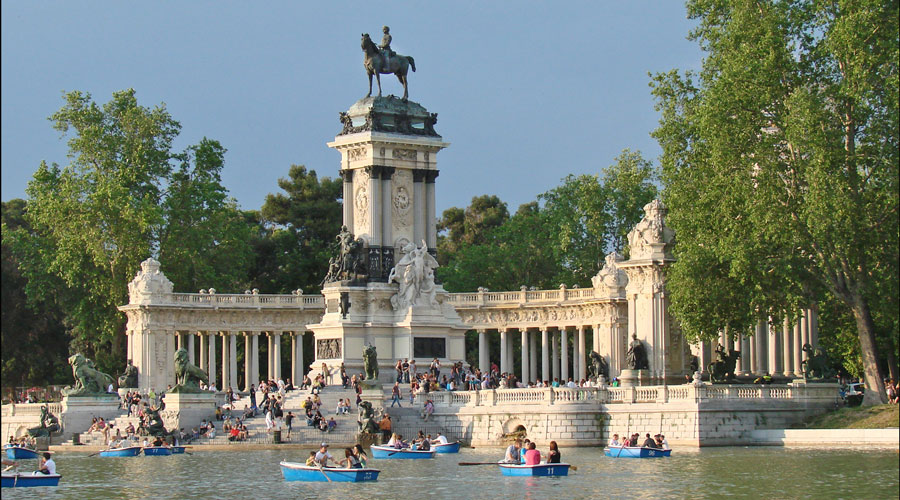
The Retiro Park – Lake
The Galapagos Fountain
Built in honour of the birth of Princess Isabella II, this statue was originally placed on the Gran Via de Madrid but was transferred to the park in 1879.
It owes its name to the Galapagos Islands located in the Pacific Ocean whose main island is the Isle of Isabella with the same name as the princess.
Made of granite and limestone, it is the work of the architect De Mariategui, who was in charge of the repairs to the Royal Palace and very much appreciated by the monarchs of his time.
It represents three fairies surrounding the young princess to protect her and four dolphins ridden by children, symbols of intelligence, wisdom, prudence but also fertility.
There are also turtles synonymous with longevity, “Galapagos” meaning “sea turtles”.
The gardens of the Retiro Park
Remnants of the ancient gardens of the Buen Retiro Palace, the gardens we know today have been redesigned and offer visitors different atmospheres when walking in the middle of nature.
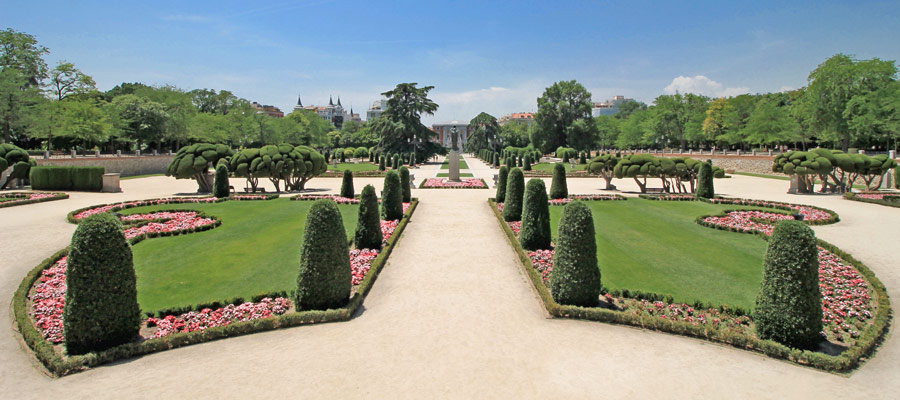
The Retiro Park – Garden
The garden of perennials
The perennial garden was created in the 1960s and offers walkers an extensive meadow, winding dirt paths and many different kinds of trees and plants such as box trees, laurels and conifers.
But also flowers such as lilies or peonies as well as aromatic plants such as rosemary.
The Dante’s gate located at the east side of the park, allows you a direct access to this garden. It owes its name to the mural sculpture of the Italian Dante Alighieri made of bronze, representing the poet who travels through paradise, purgatory and hell. Next to it is a small duck pond.
The gardens of Cecilio rodriguez
These gardens were named in honour of Cecilio Rodriguez, the former chief gardener of the park, and include various fountains such as the Gaviota fountain and its 8 columns that surround it.
There are various statues such as the mythological one representing the goddess Venus, symbol of love and beauty. This part of the Retiro Park also houses the Cecilio Rodriguez Pavilion, built entirely in red brick and in a very modern architectural style, this place hosts many public events.
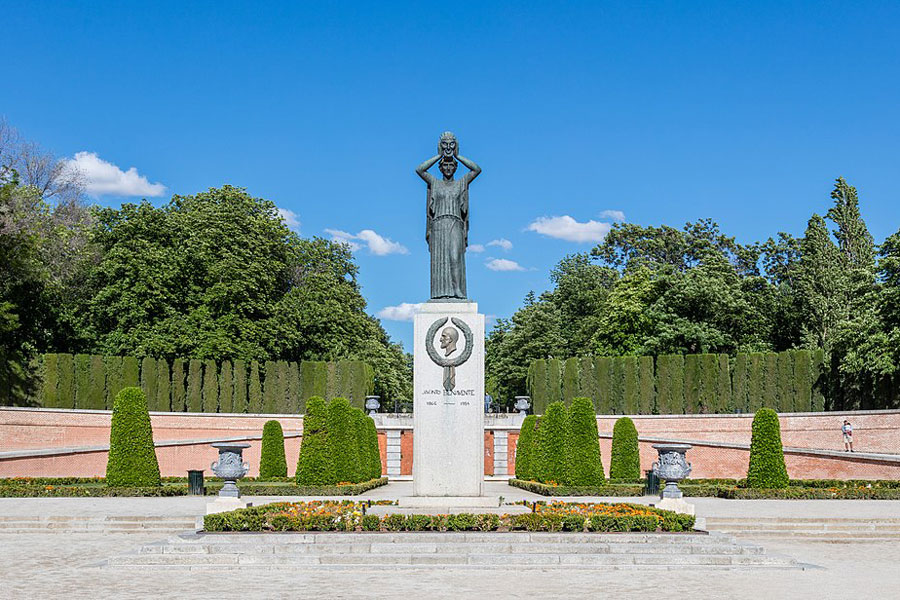
The Retiro Park – Garden
The gardens of Herrero Palacios
This garden was built on what was once the Casa de Fieras. Former zoological park that housed tigers, monkeys, elephants and even crocodiles.
Once a place of abuse, violence and fighting, it closed in 1972 to open the Zoo of the Casa de Campo outside the capital. Today, these gardens still house the monkey cage, ponds and a children’s playground.
Its direct entrance is through the Herrero Palacios gate made entirely of red bricks. These gardens and this gate are named after the municipal architect Manuel Herrero Palacios.
The rose garden of the Retiro Park
The rose garden in the Retiro Park was designed by Cecilio Rodriguez in 1915. It has more than 4,000 rose bushes, the majority of which flower in May and June.
It is a peaceful place that awakens your senses with the many scents of flowers that surround you.
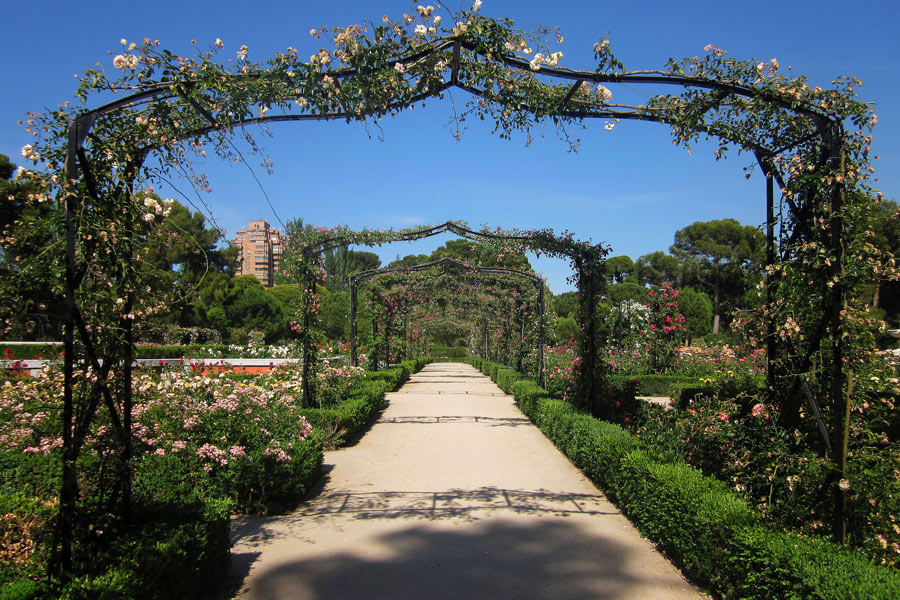
The Retiro Park – Roses
The French lawn
The French parterre of the Retiro Park was built on the former Italian-style Ochavado garden during the reign of Felipe V.
Completely destroyed during the War of Independence, it was left as a wasteland.
Today the garden is composed of a central green parterre and flowers, all arranged in geometric forms. It also includes ponds, fountains and four statues, which, as on the promenade of the statues, were used to decorate the cornice of the Royal Palace. There are also many monuments such as the one in honour of Jacinto Benavente, a Spanish playwright.
A real jewel of the Retiro Park, we recommend you to visit it when it is in bloom in spring. Its entrance is through the baroque style Felipe IV gate.
This species which composes the parterre, is very particular and known not to lose its leaves every year in autumn.
It is particularly peculiar because one of the trees in Retiro Park is known to be the oldest in the city, having been planted in 1630.

